This article may contain paid links where we make a small commission for purchases you make from links that you click from this article. By purchasing through our links, you support us at no additional cost. Thank you for your support ❤️. For more details, read the disclosure page.
Our ultimate Hiroshima itinerary will take you to the city’s most important atomic bomb historical sites in the Hiroshima Peace Memorial Park, investigating the impact of this horrific incident and the city’s hope for global peace ever since.
You’ll also see some of Hiroshima’s more modern attractions, like the Orizuru Tower, before hopping on a ferry to the nearby Miyajima Island that is a haven of breathtaking nature spots and enchanting temples!
What You’ll Get Out Of This Article
Our ultimate Hiroshima itinerary includes:
- A day exploring the Hiroshima Peace Memorial Park, which is home to UNESCO World Heritage Sites, and a memorial to the devastating impact of the atomic bomb.
- An unforgettable trip to Miyajima Island. Just an hour away from Hiroshima, the island’s breathtaking views and charming temples can’t be missed!
- A visit to a giant floating torii gate.
- Hotel recommendations and the top food spots in town.
- A handy packing guide that has everything you need for your adventure in Japan.
- The answers to some of the most common questions about a trip to Hiroshima.
Ultimate 3 Day Itinerary For Hiroshima
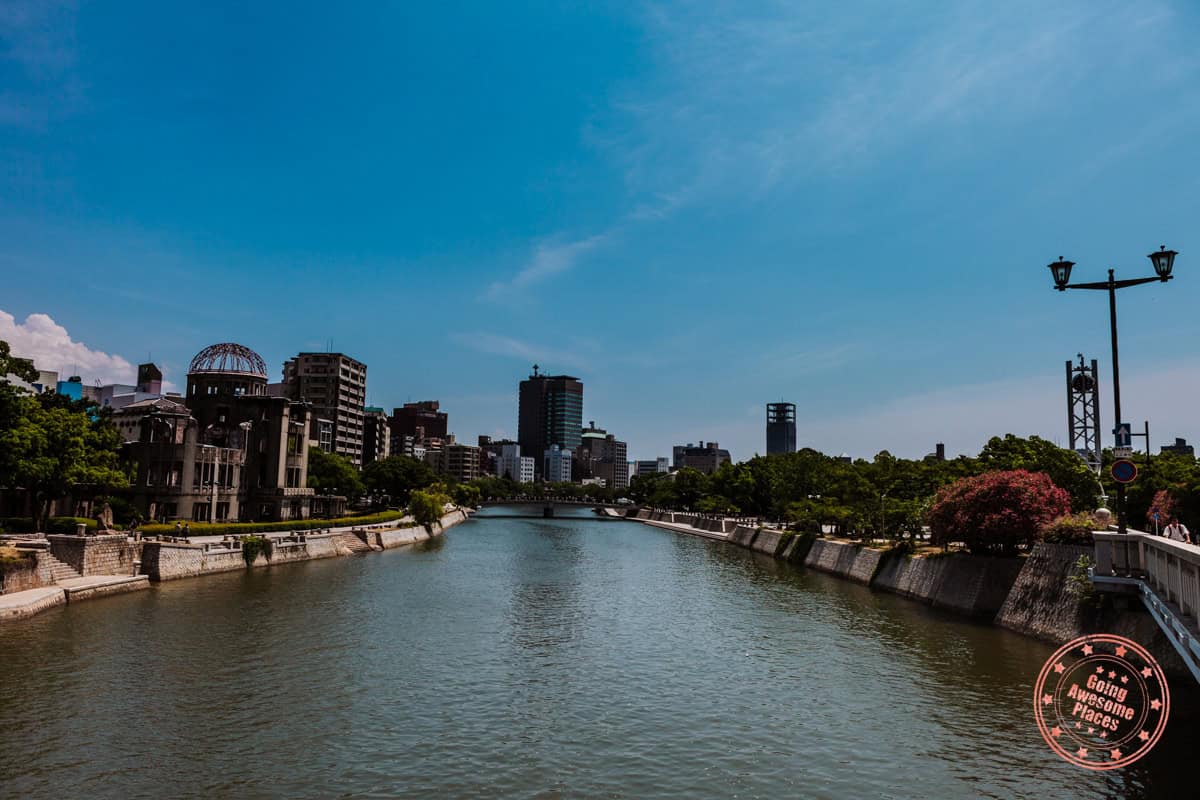
TOP TIPS FOR TRAVELING TO HIROSHIMA
- Where to stay: Grand Base Hiroshima Peace Hotel has spacious aparthotel rooms right by the Hiroshima Peace Memorial Park. We use Booking.com for all of our stays and use the Genius discount to get great deals on our hotel bookings. Alternatively, you can always see if hotel corporate codes might work for you.
- Must-pack item: Bring along a raincoat if you decide to come during the autumn season which is when the maple leaves at Momijidani Park are at their prettiest!
- Recommended tour: book this Hiroshima and Miyajima tour that squeezes all of the area’s most important attractions into a day trip!
- Car rentals – You don’t need a car for this Japan getaway, but if you decide to rent one so you can venture further afield, then make sure you know about ways to save money with car rental coupon codes and always start your search with Discover Cars and RentalCars so you know what the best deals are.
- Flights – If you are flying in from elsewhere use the Skyscanner “Everywhere” feature to find the best deals from your local airport. Check how much it would be for you to get to Hiroshima Airport!
- Insurance – Not always required but always recommended! Make sure you’re covered with the best travel insurance. Our go to is always HeyMondo.
- Hottest deals – Never be without our frequently updated travel deals page.
Get ready for an unforgettable trip filled with history, epic viewpoints, and visits to sacred temples!
📚 Hiroshima Mini Guide 📚
🏨 Best Hotel – Grand Base Hiroshima Peace Hotel
🍴Where To Eat – Mequl Cafe, Oyster Ship Kanawa, Okonomiyaki Nagataya, Social Book Cafe, Yatsunami restaurant, Parco della Pace, Miyajima Itsuki Coffee, Cafe Miyajima Base, Kakiya
🎟️ Best Places To Visit – Hiroshima Peace Memorial Museum, Hiroshima National Peace Memorial Hall, Flame of Peace, Atomic Bomb Dome, Hiroshima Orizuru Tower, Hiroshima Castle, Shukkeien Garden, Miyajima Island, Miyajima Shrine, Raikado, Momijidani Park, Daisho-in
⭐️ Must Do Activities – book this 4-hour-long tour of Hiroshima with a licensed tour guide, guided tour of Hiroshima Castle, book this Hiroshima and Miyajima tour that squeezes all of the area’s most important attractions into a day trip, Miyajima Ropeway
Hiroshima Day 1 – Learn About Hiroshima’s Nuclear Past
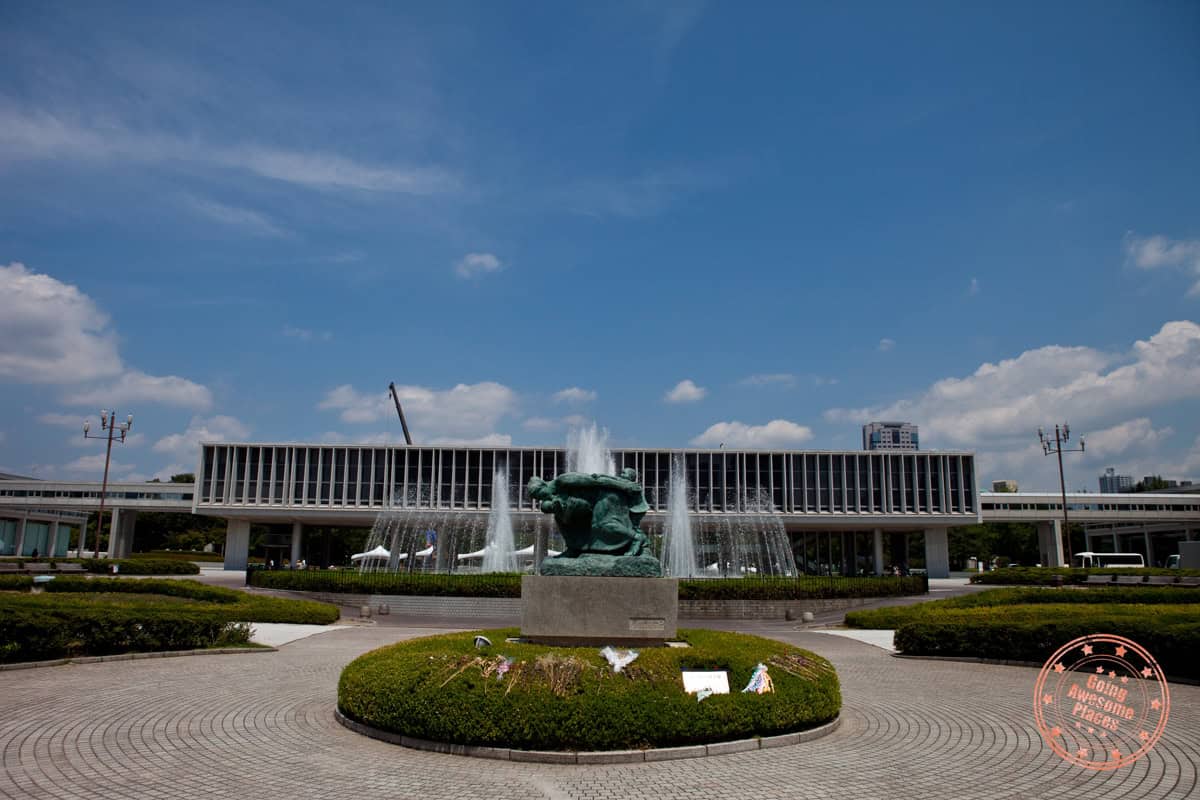
Hiroshima is pretty far away from other major cities like Kyoto and Tokyo. But we still think it’s worth visiting! You can visit it as its own itinerary, or add this itinerary onto another one like our Kyoto 4-day Itinerary or our Osaka 4-Day Itinerary.
If you’re travelling to Hiroshima from Tokyo, you should get the shinkansen bullet train. What would be a 10-hour drive is shortened to a 4-hour train ride. It’s still a pretty long trip, but it’s doable! Funnily enough, it takes as long to get to Hiroshima by train from Kyoto and Osaka as it does from Tokyo if you take a regular train.
Luckily, the shinkansen bullet train also runs from Kyoto and Osaka to Hiroshima Station so you can reach the city in just over an hour and a half. It’s worth looking into the JR pass to save money on your train tickets!
If you are traveling from another city, try to set out as early in the morning as possible so you can still go sightseeing on your first day in Hiroshima.
Once you arrive, make your way to the Grand Base Hiroshima Peace Hotel. They rent out cozy hotel apartments that are spacious and have everything you need for a short stay. Situated a short 7-minute walk from the Hiroshima Peace Memorial Park, these aparthotels couldn’t be in a better location.
Leave your stuff in your room and get ready to start exploring the city. But first, breakfast! Make your way to Mequl Cafe. They have classic breakfasts like French toast and a great tea selection.
After that, head toward the Hiroshima Peace Memorial Park which is less than a 10-minute walk away from the cafe. The park is so important it also made it onto our epic guide of the Top 5 Things To Do In Hiroshima!
Before the nuclear bomb that devastated the area when it was dropped on Hiroshima by the US on the 6th of August in 1945, the district used to be the political and commercial heart of the city. Now, the park is home to numerous peace memorial sculptures, a memorial hall, and a memorial museum.
A visit to Hiroshima isn’t complete without diving into the tragic history and impact of the nuclear bomb. There is loads to do in the park, but we recommend you start at the Hiroshima Peace Memorial Museum.
The museum is home to numerous displays of the old artifacts of atomic bomb victims, such as clothes and photos. There are also testimonies of those who were affected by the bomb, they are heart-wrenching and hard to read, but they’re an important reminder of the devastating impact of nuclear weapons.
One of the most famous artifacts in the museum are the paper cranes that were folded by Sadako Sasaki, a radiation victim who was just 2 when the nuclear bomb landed in Hiroshima. She sadly died at the age of 12 of leukemia. Her family lived a little over a mile away from the bomb’s hypocenter.
To get the most out of your trip, book this 4-hour-long tour of Hiroshima with a licensed tour guide. You’ll visit the Hiroshima Peace Memorial Park as well as the Hiroshima Castle. It’s a great way to get local insights about the city! If you just want to get a ticket to the museum and skip going on a tour, book your admission ticket in advance here.
WHAT YOU NEED TO KNOW
- Address: 1-2 Nakajimacho, Naka Ward, Hiroshima, 730-0811, Japan
- Hours: 7:30AM to 7PM each day. Last entry is half an hour before closing time.
- Price: Admission tickets to the museum cost just over a dollar.
- Tips: The museum has a lot of exhibits that are upsetting, so come prepared to learn and be impacted by what you see at the museum. We also recommend getting a ticket in advance, which you can book here through Klook.
- Getting there: The Peace Memorial Building is a short 10-minute walk away from the cafe where you’ll stop for breakfast, and just as close if you head there directly from the hotel we’ve picked out for you.

As you come out of the Peace Memorial Museum, you’ll see the Prayer Fountain, continue further up the park past the A-bombed Phoenix Trees, and you’ll find the A-bomb Ruins Exhibition Hall where you can have a glimpse at the remains of some of the buildings that were destroyed by the atomic bomb.
A little further along you’ll find the next big attraction in the park, the Hiroshima National Peace Memorial Hall. The hall is designed to make you contemplate the enormous impact that the detonation of the two atomic bombs had on Japan and serves as a memorial to those who tragically died as a result.
There is a collection of 140,000 tiles in the Hall of Remembrance that represents each of the people who died, as well as a 360-degree panorama of what the city looked like after the bomb from the hypocenter at Shima Hospital.
There’s also a library in the memorial hall where you can read the personal stories of Japan’s hibakushas, the word used for bomb survivors and those affected by exposure to radiation.
WHAT YOU NEED TO KNOW
- Address: 1-6 Nakajima-cho, Naka-ku, Hiroshima City
- Hours: The museum’s opening times change slightly from season to season. Usually, the hall is open from 8:30AM to 6:00PM, but in winter the hall is only open till 5:00PM.
- Price: Admission tickets to the museum cost just over a dollar.
- Tips: The hall is another site that is quite upsetting and shows the impact of the nuclear bomb on local people and of the city itself. Prepare to be moved and impacted by the exhibits.
- Getting there: The Peace Memorial Hall is right by the museum, so you can walk from one to the other.
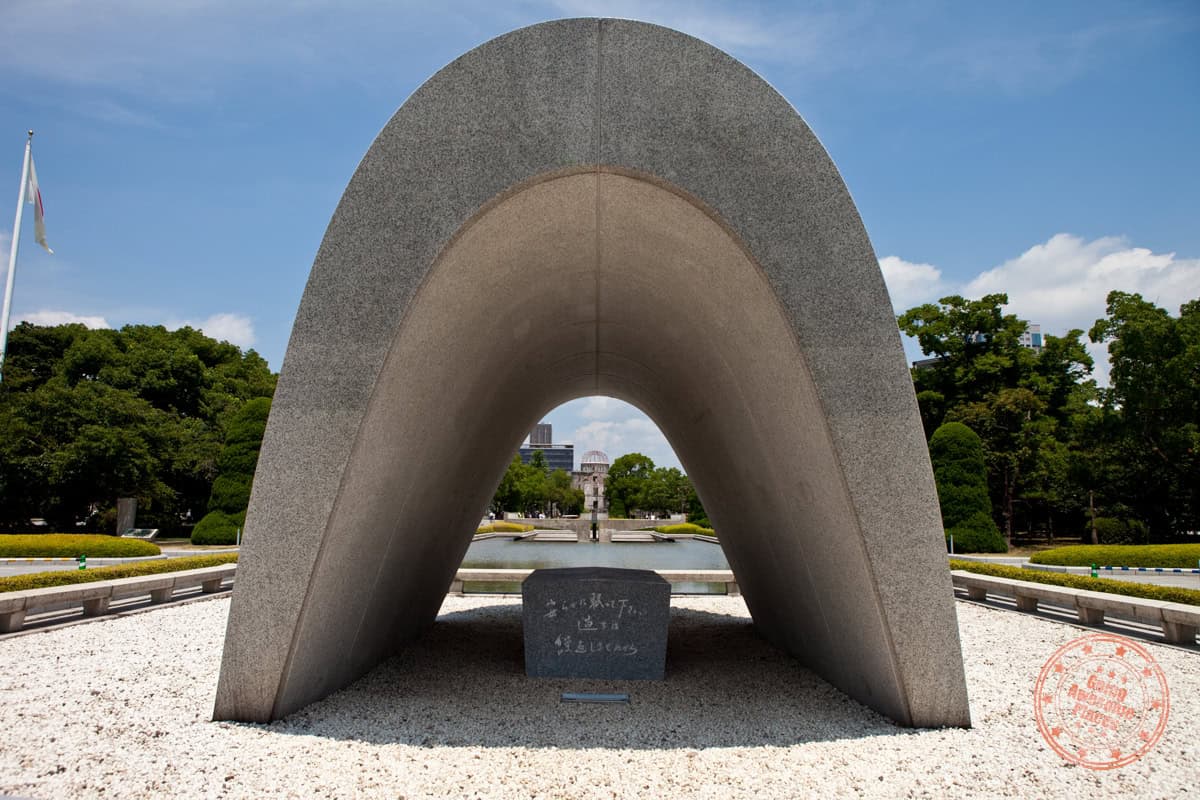
When you come out of the Hiroshima National Peace Memorial Hall, walk straight ahead and you’ll find the pond of peace. At the end of the pond, there’s the iconic Flame of Peace. Lit on August 1st in 1964, the Peace Flame has been burning ever since.
The flame represents Japan’s anti-nuclear sentiment and will continue to burn until nuclear weapons are forbidden around the world and global peace is a reality.
Surrounding the flame there’s a base that was designed by a Tokyo University professor. It represents two hands pointed upwards, symbolizing the desperate plea for water from the atomic bomb victims who had to endure the blazing fires of the bomb.
The Peace Flame has also been used to light lots of other significant flames, like the Olympic Flame of the Asian Games held in Hiroshima in 1994.
WHAT YOU NEED TO KNOW
- Address: Nakajimacho, Naka Ward, Hiroshima, 730-0811, Japan
- Hours: The flame is always burning, so you can visit it at any time!
- Price: There is no admission fee to see the Peace Flame.
- Tips: Remember that the Peace Flame is still a memorial site, so if you decide to take pictures and selfies around the flame, be mindful of being respectful.
- Getting there: The Peace Memorial Hall is right by the museum, so you can walk from one to the other.
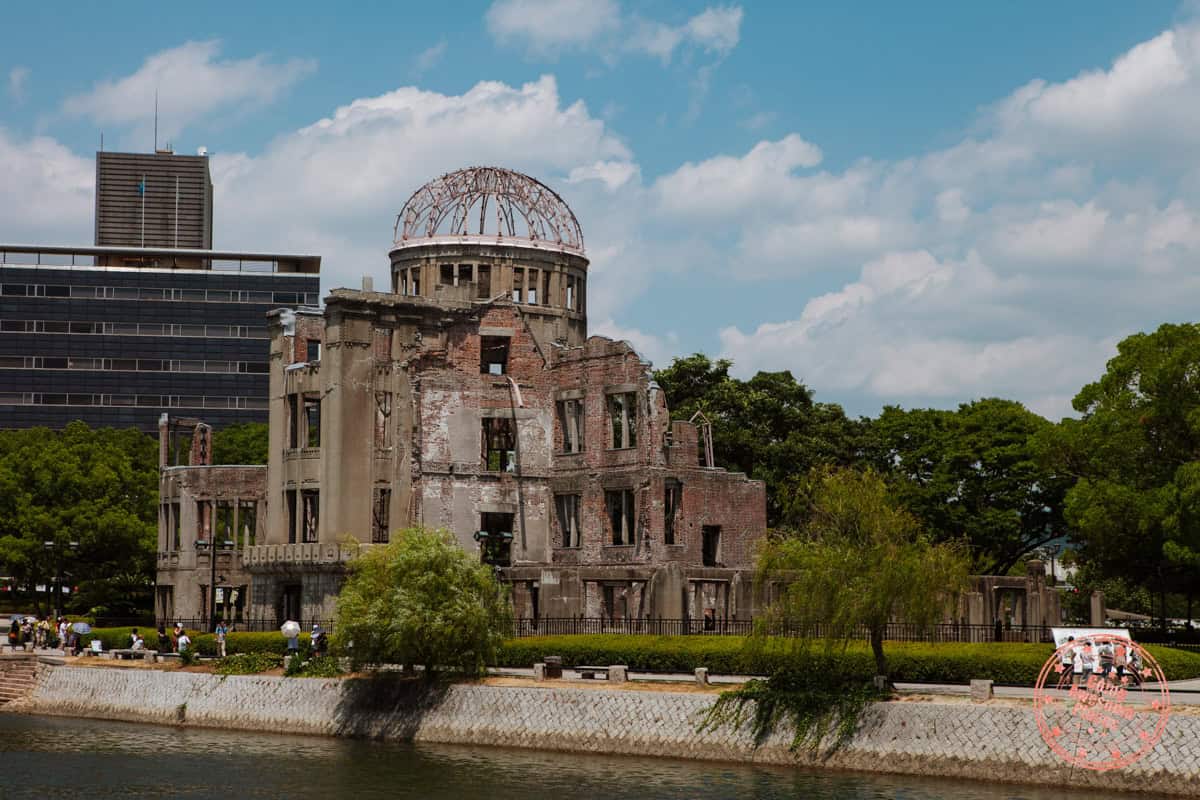
From there, walk over the Motoyasu Bridge that crosses over the Motoyasu River and connects one side of the park to the other and walk the less than 5-minute walk to the Oyster Ship Kanawa. The restaurant is positioned along the riverside, so there are stunning views. They’re renowned for their delicious fresh oysters. You can even order peculiar dishes like whisky oysters and oyster dumplings!
Walk back up along the river and you’ll come to the Atomic Bomb Dome in less than 10 minutes. A UNESCO World Heritage Site, the building was the only one left standing in the area when the atomic bomb exploded in 1945. The old ruins have been kept exactly as they were, and it’s an eerie reminder of the destruction that was caused.
The building was originally built in 1915. Local products from the Hiroshima prefecture were sold from the building, and art exhibitions were often run in the dome building. But, now only a shell of what it once was is left.
When the bomb dropped, the building was instantly set alight, and sadly, everyone inside the building was killed. The most notable feature of what still remains of the half-fallen building is the exposed steel dome.
When it is time for dinner, stop at the nearby Okonomiyaki Nagataya restaurant that’s on the route back to your hotel. They serve delicious traditional Hiroshima okonomiyaki. They’re so good that there’s often a queue, but it’s worth the wait! What could be tastier than a savory pancake layered with soba noodles, toppings of your choice, and a sauce packed with flavor.
After seeing the dome and having a traditional dish for dinner, head back towards your hotel after a long day learning about the tragic local history of Hiroshima, don’t worry – tomorrow will be a more lighthearted day!
WHAT YOU NEED TO KNOW
- Address: 1-10 Otemachi, Naka Ward, Hiroshima, 730-0051, Japan
- Hours: You can wander around the ruins of the atomic bomb dome anytime.
- Price: There is no admission fee.
- Getting there: The Peace Memorial Hall is right by the museum, so you can walk from one to the other.
Hiroshima Day 1 Summary
What you’ll see and do:
- Learn about the tragic history of the Hiroshima nuclear bomb and read the real-life testimonies of atomic bomb victims at the Hiroshima Peace Memorial Museum.
- See the 360 panorama of Hiroshima city after the nuclear bomb detonation at the Hall of Remembrance.
- Check out the Flame of Peace, which was lit in 1964 and will burn until nuclear weapons are abolished.
- What’s left of the Atomic Bomb Dome, the only building in the area that still stood after the bomb.
Where you’ll eat:
- Breakfast: Have your first coffee of the day and a French toast breakfast at Mequl Cafe just around the corner from your hotel.
- Lunch: Try the unique oyster dumplings at the gorgeous riverside restaurant Oyster Ship Kanawa.
- Dinner: Try the delicious Hiroshima Okonomiyaki pancakes at Okonomiyaki Nagataya. You can get them topped with udon or soba noodles – they’re so good that we recommend trying both!
Where you’ll stay:
- We’ve chosen the Grand Base Hiroshima Peace Hotel for your stay in Hiroshima because they have cozy apartments that are great for a range of travelers. Whether you’re traveling as a family or as a couple, they have an apartment that’ll work for your needs!
Hiroshima Day 2 – Keep Sightseeing And Visit The City’s Modern Attractions
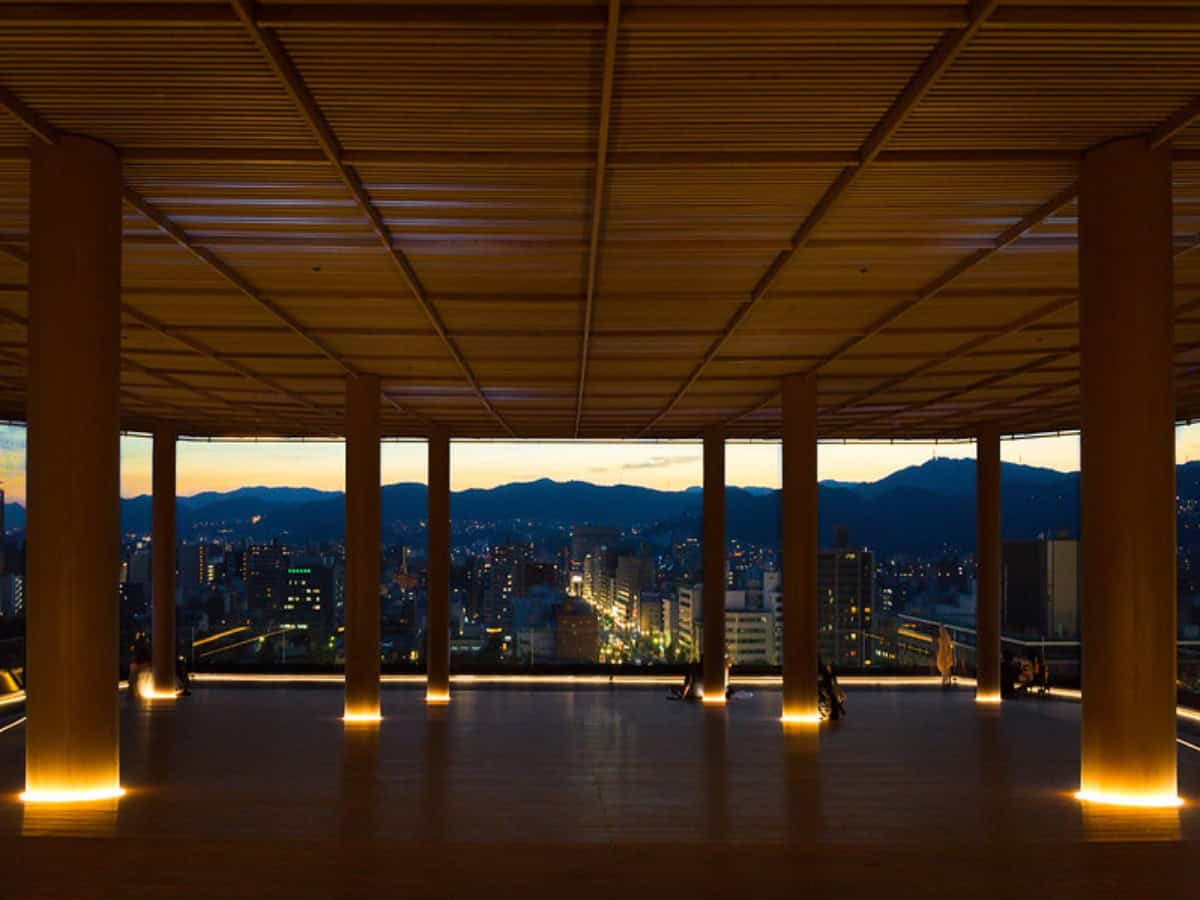 Image via Flickr by Sam García
Image via Flickr by Sam GarcíaBefore heading back out into the city for a day of sightseeing, stop for breakfast at the cute and trendy Social Book Cafe near your hotel. The cafe has guest A-bomb survivors who come and speak there every month about their experiences, and they run a lot of awesome social projects and workshops. They also sell great bagels!
After that, wander back through the Peace Memorial Park and over the Motoyasu Bridge towards the Hiroshima Orizuru Tower, which is just over 10 minutes away by foot. The tower is by the Atomic Bomb Dome building and is a popular viewpoint.
It’s one of the tallest buildings in the area so there are great views of the top of the Atomic Bomb Dome building, across the river and Peace Memorial Park, and of the mountains in the distance.
The viewpoint is on the top floor of the building. There’s a winding spiral staircase that weaves through the building to the top floor, or you can take the elevator.
One of our favorite things about the Hiroshima Orizuru Tower is that there are no walls. There’s a large wooden roof that protects you from the elements on a rainy day, but other than that, there’s only a wire mesh for walls. Feel the wind on your face as you soak in the panoramic cityscape views!
One floor below the observation deck, you’ll find a cool interactive multimedia zone. They have a cool time-lapse that shows how Hiroshima city has changed since the war till now and predicts what it might look like a hundred years into the future.
You can also buy origami paper that they’ll teach you to fold into orizuru, or paper cranes. After, you can drop your paper crane into the Orizuru Wall, a glass panel wall that’s filled with paper cranes other people have made that will one day cover the outside wall of the Orizuru Tower.
Get your admission ticket to the observation deck and multimedia floor ahead of time here! There is also a little cafe and souvenir shop on the bottom floor if you want to buy anything on your way out!
WHAT YOU NEED TO KNOW
- Address: 1 Chome-2-1 Otemachi, Naka Ward, Hiroshima, 730-0051, Japan
- Hours: The tower is open from 10AM until 6PM each day. Last admission is half an hour before closing time, but we recommend leaving at least an hour or ideally two for the tower since there’s the art staircase and interactive multimedia floor as well as the observation deck.
- Price: You can get a ticket ahead of time for $15.
- Tips: Even though it’s tempting to take the lift, take the stairs to the observation deck! There are displays of pieces by local artists along the staircase that make it worth the extra effort.
- Getting there: The tower is super close to the breakfast cafe we’ve chosen, so the easiest way to get there is by foot.
 Image via Unsplash by Nicholas Doherty
Image via Unsplash by Nicholas DohertyWhen you’ve made a paper crane to add to the outer wall of the Orizuru Tower and you’ve taken in the stunning views over the city and beyond, make your way to the Hiroshima Castle. Also known as the Carp Castle, it’s a short 15-minute walk away from the tower so we recommend getting there by foot.
Five storeys high, you’ll spot the enormous castle from afar! If you’re expecting anything like a medieval European castle, you’re in for a surprise. Like a lot of Japan’s castles, Carp Castle looks more like a temple than a castle.
The castle is surrounded by a moat, and within its confines, there’s a little shrine and old ruins. Sadly, what you see today isn’t the original castle. Built in 1589, the old Hiroshima Castle managed to survive the demolition that lots of Japan’s castles faced during the Meiji Period, but it was unfortunately destroyed in 1945 by the atomic bomb.
If you want to learn more about the castle’s history, you can check out the little museum on the grounds. We’d also suggest setting aside an hour or so to wander around the castle grounds. There are scenic city views and the park is pretty cute.
History enthusiasts will love this guided tour of Hiroshima Castle that includes loads of insight about life in the Edo period as well as an in-depth rundown of the castle’s fascinating history.
WHAT YOU NEED TO KNOW
- Address: 21-1 Motomachi, Naka Ward, Hiroshima, 730-0011, Japan
- Hours: The castle is open from 9AM to 6PM each day, apart from during the winter months when it closes at 5PM.
- Price: Admission to the castle grounds is free, but if you want to go into the castle, it costs around $3.
- Tips: Set aside some time to walk around the castle grounds. There are cool views of the city, and it’s a great way to escape the hustle and bustle of the city for a little while.
- Getting there: The castle isn’t far from the Orizuru Tower. As it’s just a 15-minute walk away, the easiest way to get there is to ditch the public transport and go by foot.
 Image via Unsplash by Ponglada Niyompong
Image via Unsplash by Ponglada NiyompongAfter visiting the castle, head for lunch at Yatsunami restaurant. We couldn’t get enough of the regional Hiroshima Okonomiyaki pancakes, so we found another local restaurant that serves them for today’s lunch. Don’t worry, there are other things on the menu if you want to try something else, but they’re so delicious we’re sure you won’t!
Once you’re full, make your way to the Shukkeien Garden, that’s just 10 minutes’ walk away. The garden’s name translates to the ‘shrunken-scenery garden’, which is a fitting name for this picturesque little garden!
The garden has been designed to look like it has miniature valleys, mountains, and forests running through it. You can get a real sense of Japan’s wild landscapes without actually needing to venture into the country’s rural areas.
Stop for a rejuvenating cup of matcha tea at one of the tea houses surrounding the pond in the centre of the garden, then continue along the path that winds its way around the gardens’ many miniature landscapes. Dating back to 1620, the little garden has been slowly perfected over hundreds of years!
Once you’ve explored the charming garden landscape, make your way towards Parco della Pace. Even though it’s an Italian restaurant, their stone-baked pizzas are so good we couldn’t help including it in the itinerary. The best part? It’s just around the corner from your hotel so you don’t even have to go out of your way to get there!
WHAT YOU NEED TO KNOW
- Address: 2-11 Kaminoborichō, Naka Ward, Hiroshima, 730-0014, Japan
- Hours: The garden is open from 9AM to 5PM each day.
- Price: There is a small admission fee to get into the garden, but it’s less than $2 so it won’t break the bank! It’s also worth knowing that they only let up to 60 people in at once, so if you arrive on a busy day, you might have to wait for a little bit to go in.
- Tips: Make sure you stop for a tea by the pond – the tranquil atmosphere and lush greenery of the garden around you make the tea taste extra good!
- Getting there: The garden is a 10-minute walk away from the nearby Hiroshima Castle, so it’s easy to reach by foot.
Hiroshima Day 2 Summary
What you’ll see and do:
- Climb to the observation deck at the top of the Orizuru Tower then make your own paper crane to add to the tower’s glass wall.
- Immerse yourself in the local history at Hiroshima Castle.
- Slow down and enjoy the miniature landscape and teahouses at the picturesque Shukkeien Garden.
Where you’ll eat:
- Breakfast: Stop for a breakfast bagel at the epic Social Book Cafe. It’s worth checking to see their opening times before walking there as their schedule changes from day to day and they aren’t always open. Alternatively, you can have another delicious breakfast at Mequl Cafe!
- Lunch: Refuel on the regional best, Hiroshima Okonomiyaki pancakes at Yatsunami restaurant. Who knew that a pancake with cabbage in it could taste so good! There are loads of sauces to choose from, so try a new flavor today.
- Dinner: Try the incredible stone-baked pizzas at Parco della Pace. They’re so good we had to ditch the local Japanese cuisine for a night.
Where you’ll stay:
- Grand Base Hiroshima Peace Hotel has spacious apartments for rent that are much nicer than Japanese hotel rooms that are often on the small side! It’s also in a great location, less than a 10-minute walk away from the Hiroshima Peace Memorial Park.
Hiroshima Day 3 – Explore Miyajima Island
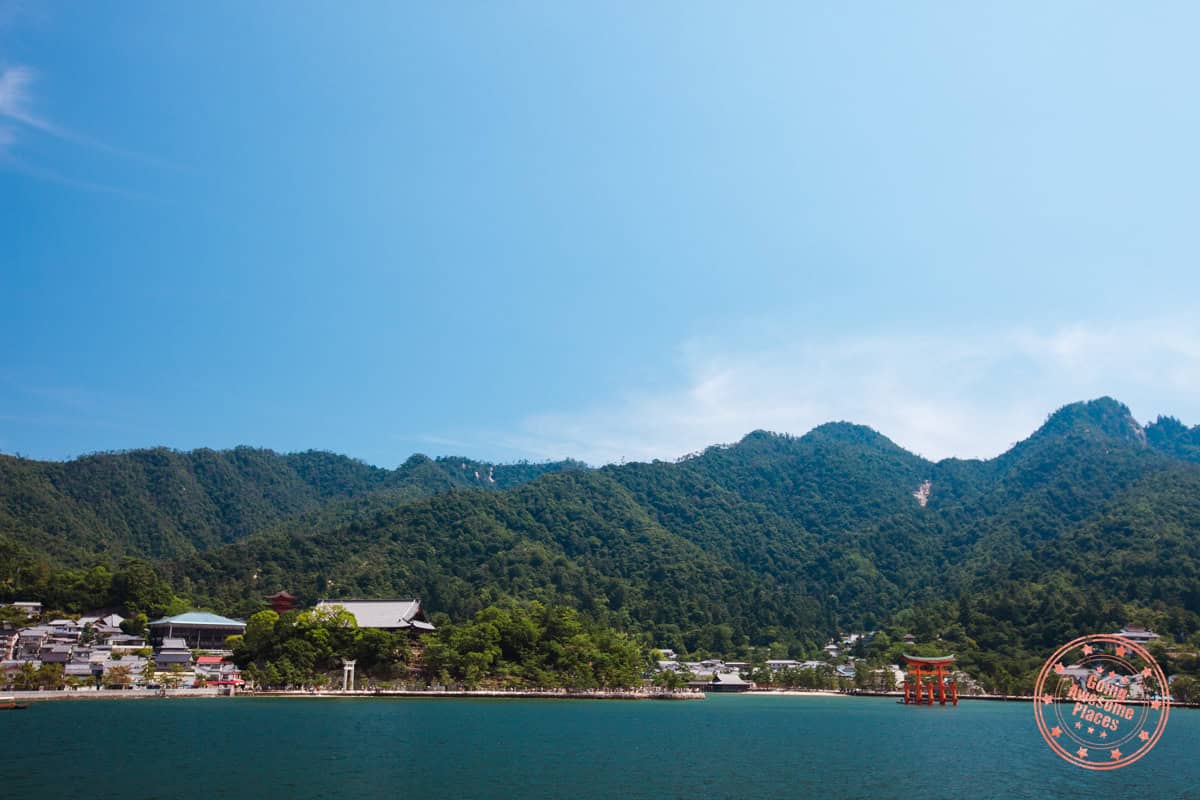
Miyajima Island is just off the coast of Hiroshima. Its formal name is Itsukushima Island (which is how it appears on Google Maps if you’re looking for it!) and it’s a popular destination among travelers. A trip to Hiroshima isn’t complete without a quick island hop and a day trip to Miyajima!
You can reach the island by ferry or train in less than an hour from Hiroshima. Once you’re actually on the ferry the boat ride only takes about 20 minutes, but it can take a while to reach the pier depending on which neighborhood in Hiroshima you’re staying in. There’s also a small visitor tax fee that gets added onto your ferry ride or train ticket when you go to Miyajima, but it’s less than a dollar, so it’s nothing to worry about.
WHAT YOU NEED TO KNOW ABOUT GETTING THE FERRY TO MIYAJIMA ISLAND
There are three ferry options you can choose from to get from Hiroshima to Miyajima Island. You can get a ferry from the city’s port, a JR ferry (which is covered by the JR Pass) from the JR Ferry terminal, or you can catch an express ferry from the Peace Memorial Park.
- Express ferry from the Peace Memorial park: This option is the fastest and most direct way to reach the island. Because the hotel we’ve is just a few minutes walk away from the Peace Memorial Park, we recommend this option!
- Run by the company Aquanet, the ferries leave from the Motoyasu Bashi Pier which is by the A-Bomb Dome, beside the Motoyasu Bridge. As well as being the quickest way to get there, it’s also a great way to see the city from the water! The route is known as the ‘Hiroshima World Heritage Sea Route’ because it travels along the Hiroshima River.
- The only drawback of the Hiroshima World Heritage Sea Route is that sometimes the ferries don’t operate because of the water levels. The tidal nature of the river means that sometimes they have to cancel their ferries, this is especially common in spring. Check if the ferry is running and the exact timetable for that day here.
- The journey to Miyajima Island takes about 40 minutes and costs about $27 for a return ticket. You can get your tickets at the pier so you don’t need to book in advance.
- Ferries from Hiroshima Port: First Beach Co. Ltd operate ferries from the city’s port. We’d only recommend using them if Aquanet’s express ferries aren’t running, or if you have a JR Pass and you want to save some money.
- First Beach Co. Ltd have frequent ferries from the port. The journey takes about half an hour and their return trips cost about $23. If you choose to travel with them, you can check out their scheduled timetable here. Bear in mind you’ll need to factor in an extra 45 minutes of travel time to reach the port by bus from our recommended hotel.
- JR Ferries: The last option is to catch the JR Ferry to Miyajima. Although it’s the longest travel option, it might be worth it if you have the JR Pass! You’ll need to catch a tram from Hiroshima Peace Park to the JR Hiroshima Station, which is about 50 minutes away.
- From there, hop on the local JR Sanyo line to Miyajimaguchi and walk to the JR Ferry terminal a 2-minute walk away. Hop on the JR Ferry that reaches the island in just 10 minutes!
- Whilst this is the longest way there, if you have the JR Pass you’ll only need to pay for the tram, so getting there and back will only cost you $3.50. Check their scheduled departure times here.
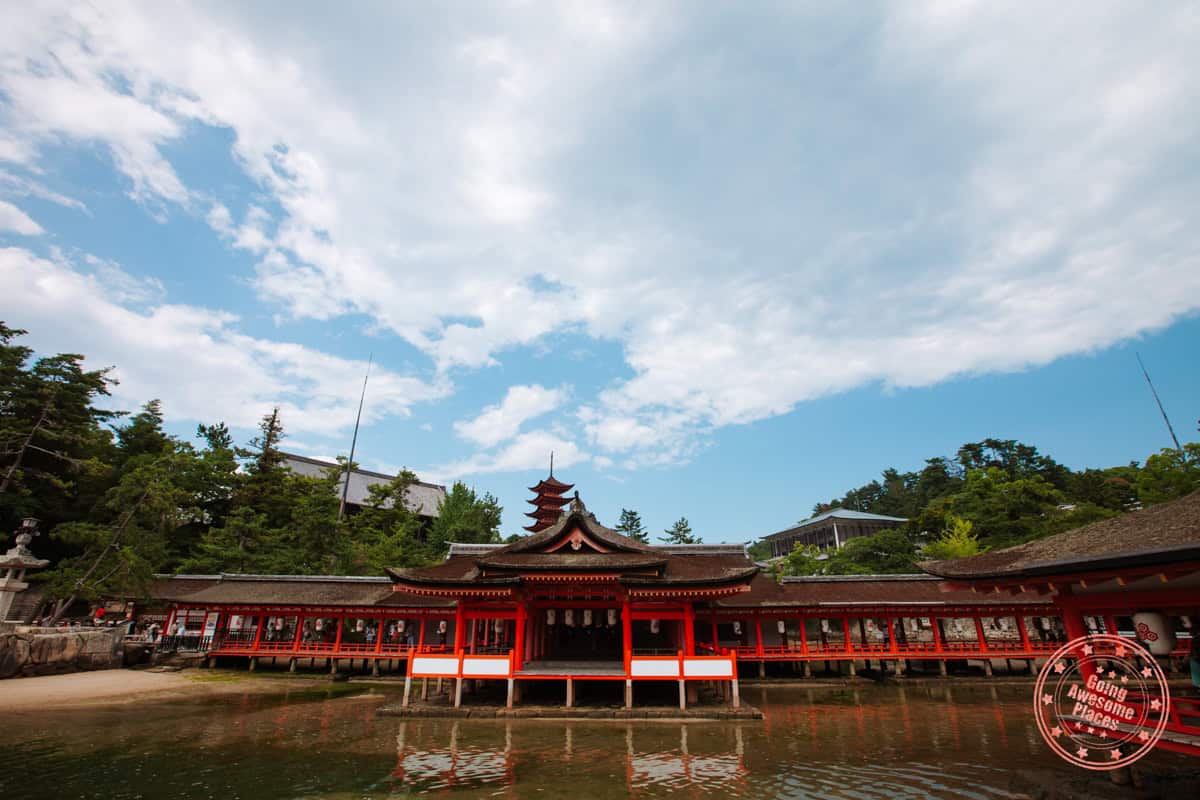
Once you arrive on the little island, make your way to the Miyajima Shrine. It’s a short 15-minute walk away from the island’s pier so the best way to get there is by foot.
Before going into the shrine, stop for breakfast at Miyajima Itsuki Coffee. They’re the only coffee roasting company on the island, and they take their coffee very seriously! They even sell coffee-flavored ice cream. Grab a cup to go and wander over to Miyajima Shrine!
The shrine is the most important of all the attractions on the island, and also its namesake. Miyajima literally translates to ‘shrine island’! By the temple, there’s also an enormous red torii gate that will catch your attention the moment you arrive! It’s such an iconic Hiroshima monument that it made it onto our epic guide of the Top 5 Things To Do In Hiroshima!
Built further out than the island’s houses, the shrine and torii gate appear to be floating on the open water during high tide. The shrine’s various quaint buildings are supported by pillars and connected by wooden boardwalks.
Miyajima Island has been considered a holy site in the Shinto religion for centuries. It’s known that locals have worshipped the island’s famous mountain, Mount Misen, since as early as the 6th century.
It’s no wonder then that when Taira no Kiyomori, one of the most prominent men in the country during the Heian Period, decided to build a family shrine he picked Miyajima Island! In 1168, his idea came to life, and this stunning floating shrine has been there ever since.
Make sure you snap some photos with the iconic torii gate before you leave!
If you decide to stay on the island for a night, you can also see the shrine and torii gate lit up at night. There are even little boat tours that take you out into the water and sail around the temple complex!
Pressed for time? Then book this Hiroshima and Miyajima tour that squeezes all of the area’s most important attractions into a day trip! That way, you don’t have to worry about the logistics or have to miss anything.
WHAT YOU NEED TO KNOW
- Address: 1-1 Miyajimacho, Hatsukaichi, Hiroshima 739-0588, Japan
- Hours: The shrine is open from 6:30AM to 6:00PM from March to October, but it closes at 5:30PM during the winter months.
- Price: Admission to the shrine costs just $2.
- Tips: Remember to check the tides before you visit Miyajima Shrine. During high tide the torii gate and shrine buildings look like they’re floating, which is super impressive. But going at low tide also has its perks. As your water leaves the little bay, you can walk out to the torii gate. Getting up close to it is the only way to get a real understanding of how enormous it is!
- Getting there: In total, it’ll take you about an hour and a half to reach the shrine from our chosen hotel. Check out our breakdown of the different ways to reach the island by ferry and pick your preferred option!
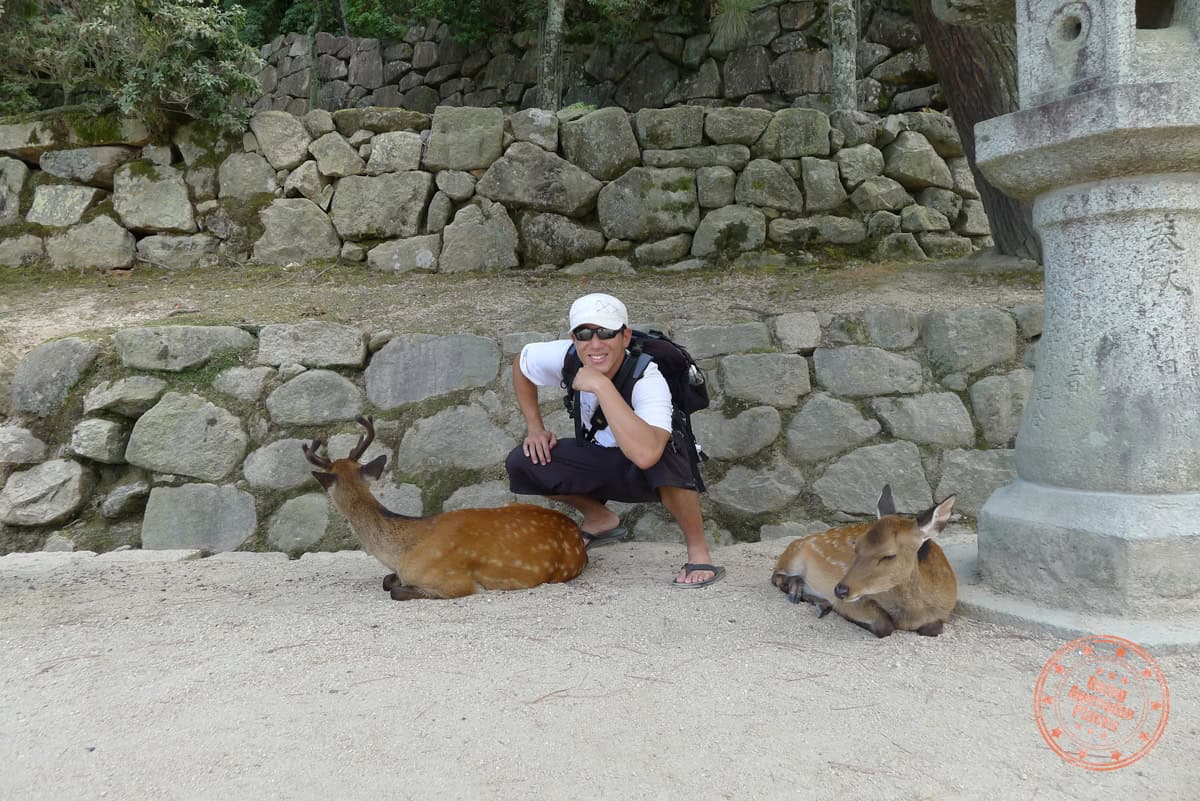
Luckily, Miyajima Shrine is a short 15-minute walk away from where the ferry’s coming from Hiroshima dock on the island.
After visiting the shrine, take a short 10-minute hike to the Miyajima Ropeway. Keep a look out for the free-roaming deer that live on the island and can often be spotted wandering through town on your way there!
The Miyajima Ropeway travels up to the top of Mount Misen, the island’s highest peak. From the top there are awesome views of the Seto Inland Sea and Hiroshima in the distance! Of course, you do have to get lucky with the weather, so try to plan your trip on a clear day if you want to guarantee the best views.
If you’re lucky, you might even spot one of the island’s rare monkeys from above as you climb towards the top of Mount Misen!
The ropeway will drop you off at the Shishi-iwa Observatory. To reach the very top of the mountain, there’s a short uphill hike from there. But it’s worth the extra effort to see the rest of the Daisho-in Temple buildings that were built on the summit of Mount Misen (the rest of the temple is at the mountain’s base, and we’ll be heading there next!).
Make sure you visit the Raikado (Hall of the Spiritual Flame) building. The flame is said to have been lit by Kobo Daishi, one of Japan’s holiest religious figures, when he began worshipping on Mount Misen. It has been burning ever since and was also used to light the Flame of Peace in Hiroshima’s Peace Park!
WHAT YOU NEED TO KNOW
- Address: Japan, 〒739-0522 Hiroshima, Hatsukaichi, Miyajimachō, 紅葉谷公園
- We couldn’t find an address without Japanese characters in it, but if you type Miyajima Ropeway into your Google Maps or use the interactive map we’ve created for you, you’ll find it without any problems!
- Hours: The ropeway runs from 9:00AM to 4:00PM. The last ride down from the top of the mountain is at 4:30PM.
- Price: A return trip on the ropeway costs a little more than $13. But it’s worth it considering the hike to reach Mount Misen’s summit takes almost two hours!
- Tips: If you’re coming in autumn, don’t forget to pack a raincoat! The top of Mount Misen can get very misty and autumn is Japan’s wettest season.
- Getting there: The ropeway is just a 10-minute walk away from Miyajima Shrine.
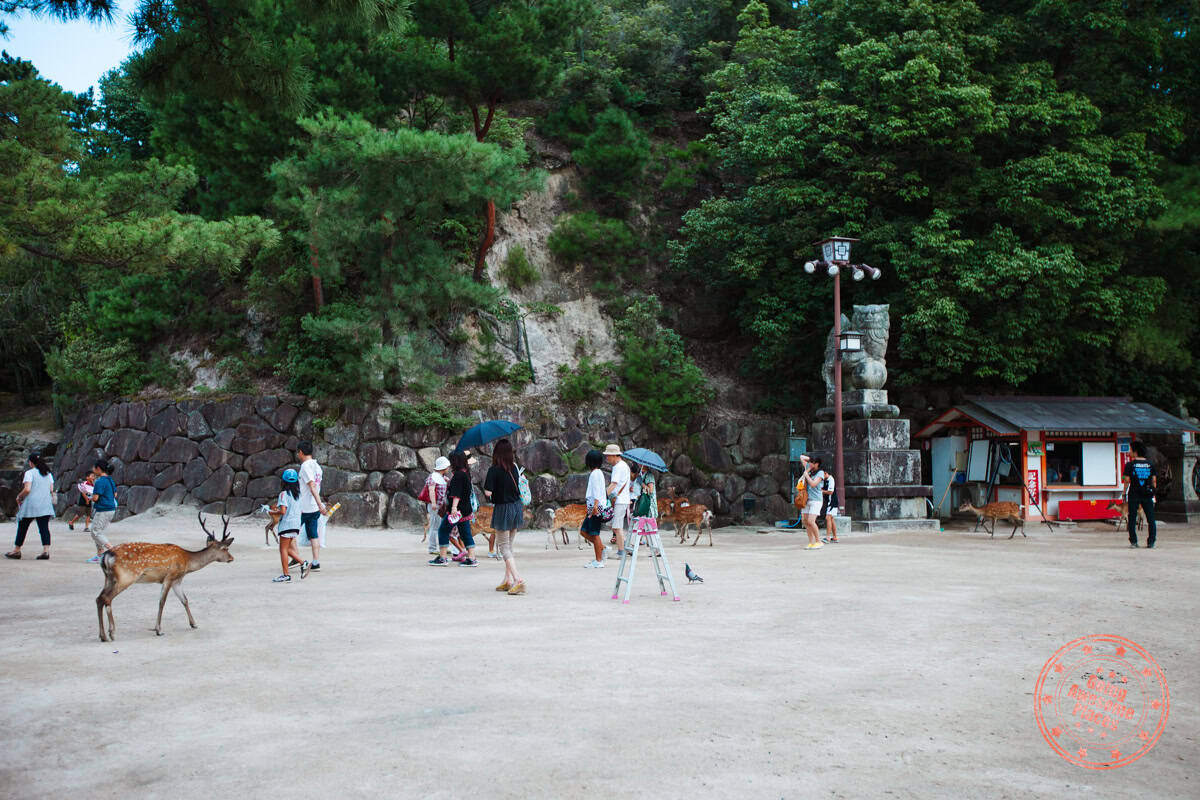
Just 2 minutes away from the Miyajima Ropeway, you’ll find Momijidani Park. Take a moment away from the crowds and enjoy a tranquil walk through the lush trees and over the little bridges dotted around the park.
Keep a lookout for the little deer that live in the park too! They’re not shy, so you’re very likely to see them whilst you’re there.
The park is especially beautiful in the fall season when all the maple trees’ leaves turn vibrant hues of red and orange!
WHAT YOU NEED TO KNOW
- Address: Japan, 〒739-0588 Hiroshima, Hatsukaichi, Miyajimacho, 紅葉谷
- Don’t worry about the Japanese characters in the address, you can easily find it by typing Momijidani Park into your Google Maps or using our interactive map that you can download ahead of your trip!
- Hours: The park is always open.
- Price: There’s no admission fee to go into the park, it’s completely free!
- Tips: If you want to see the park at its most beautiful, visit during the fall season.
- Getting there: The park is right by the Ropeway, just a couple of minutes’ walk away.
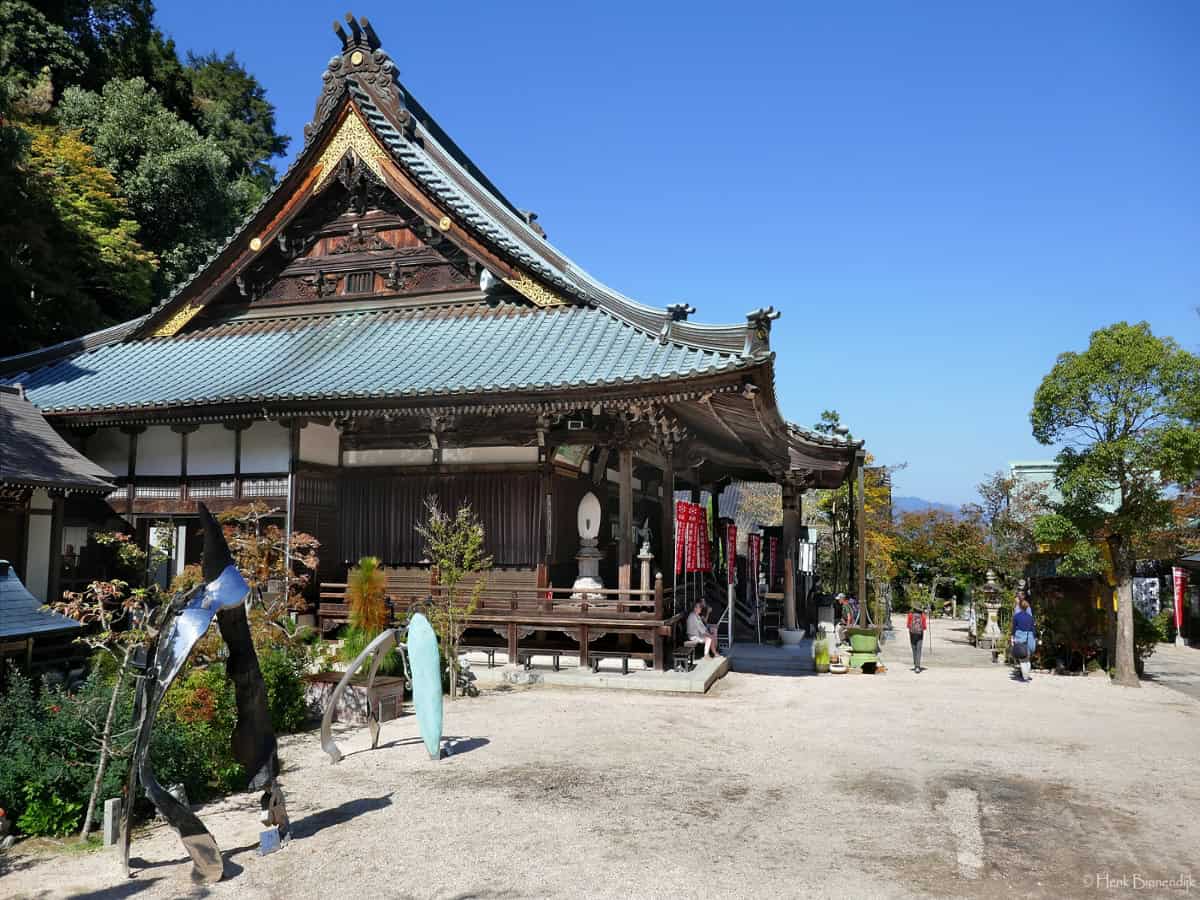 Image via Flickr by Henk Binnendijk
Image via Flickr by Henk BinnendijkAfter walking around the summit of Mount Misen and exploring Momijidani Park, you’ve probably worked up an appetite! Once you’ve traveled back down the mountain, make your way to Cafe Miyajima Base that’s a short 15-minute walk away. They serve super tasty fried chicken with rice and curry on the side!
Filled up and ready for the next attraction? Head over to Daisho-in that’s just around the corner from where you’ve had lunch. You’ve already seen some of the temple’s buildings at the top of Mount Misen, but most of the temple complex is at the mountain’s base.
It was the first Buddhist temple built on Miyajima, by Kobo Daishi, who brought Shingon Buddhism to the island. As you walk up the steps to the temple, you’ll see a row of spinning metal wheels that are inscribed with Japanese prayers.
Even if you don’t speak Japanese, you can still receive the blessings that reading the sutras is believed to bring by spinning the wheels on your way up the steps! If you do want to learn some Japanese, check out my article about using the Rosetta Stone app to learn Japanese. It’s so good it even made it onto our 12 Of The Best Apps For Japan Travel article!
One of our favorite areas of the temple was the little garden decorated with 500 miniature Rakan statues that depict one of Buddha’s students. Adorably, every little statue is decorated with a colorful beanie hat!
WHAT YOU NEED TO KNOW
- Address: 210 Miyajimachō, Hatsukaichi, Hiroshima 739-0588, Japan
- Hours: The temple is open from 8:00AM to 5:00PM each day.
- Price: One of the things we love about this unique temple is that it’s completely free!
- Tips: Don’t miss the garden with 500 miniature Rakan statues! If you look closely, you’ll see that each statue has a distinct facial expression. We loved seeing all the unique beanie hats they’re wearing too.
- Getting there: The shrine is just a 15-minute walk away from Momijidani Park, so like all the attractions on Miyajima Island, you can walk to it.
After seeing the temple, wander back to the ferry pier and have dinner on the island before you hop on a return boat to Hiroshima.
Since it’s your last night in the area, we’ve found a great seafood restaurant for you to eat at! Kakiya is in the popular Omotesando street. They’re one of the best spots on the island for fresh oysters, a Hiroshima delicacy!
Hiroshima Day 3 Summary
What you’ll see and do:
- Visit the iconic Itsukushima Shrine that the island is named after!
- Travel to the top of Mount Misen on the Miyajima Ropeway and soak in the views over the coast and of Hiroshima in the distance.
- Take an afternoon stroll through the stunning Momijidani Park, which is famous for its colorful maple trees!
- Find your favorite beanie hat among the 500 Buddha statues at Daisho-in Temple.
Where you’ll eat:
- Breakfast: Miyajima Itsuki Coffee is the only coffee roasting company on the island, and their coffee is out of this world!
- Lunch: Make your way to Cafe Miyajima Base and get your hands on some of their amazing fried chicken.
- Dinner: Fill up on garlic oysters at Kakiya.
Where you’ll stay:
- Grand Base Hiroshima Peace Hotel is our top pick for this Hiroshima itinerary because it’s suited to all kinds of travelers, from backpackers to families!
- If you want to look for another hotel option, check out our Where To Stay In Hiroshima Guide, we’ve got loads of hotel recommendations and information about each of the neighborhoods!
Interactive Map Of Hiroshima And Miyajima Island
We’ve designed this handy interactive map with all the restaurants and attractions on this itinerary pinned for you! Leave the logistics to us and download this awesome map before your trip.
[Insert Google map underneath]
The History Of Hiroshima
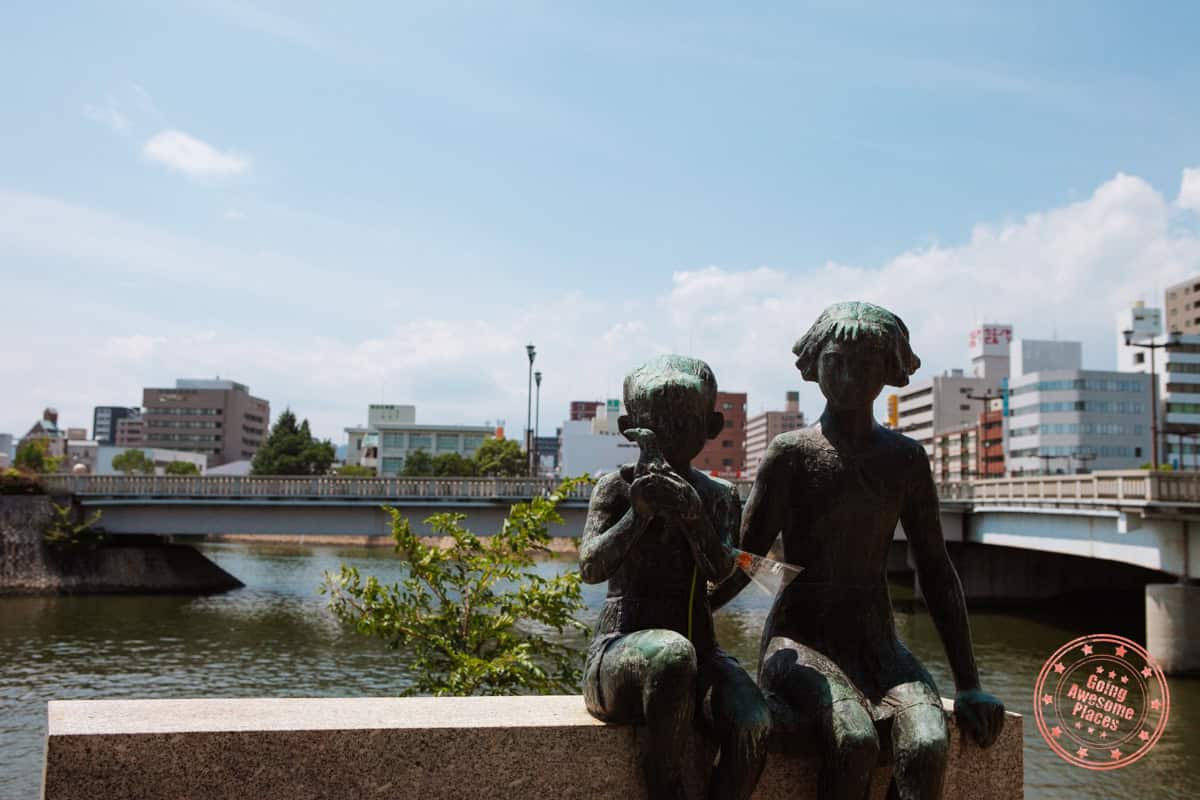
Hiroshima is the capital of the prefecture of the same name. It’s a vibrant city with a tragic history. Founded in 1589 along the Ota River delta, it quickly became one of Japan’s most prominent cities.
Sadly, in 1945, Hiroshima was the site of the first ever targeted nuclear weapon. The atomic bomb destroyed most of the city, killing between 90,000 and 166,000 people by the end of the year. Radiation became a huge problem, and the city is only just recovering from the impact of this devastating incident.
Hiroshima has fought to make peace an integral part of the city’s values ever since, and the Hiroshima Peace Park is a testament to that.
Hiroshima Packing Guide
You can pack for Hiroshima like you would for any city break. Bring casual but comfortable clothes, and maybe throw in a nice outfit in case you want to go for a nice meal one evening. Here is a handy list of more specific items to consider bringing:
- Comfortable shoes: Wandering around Hiroshima and Miyajima, visiting all the nuclear bomb memorial sites and other attractions, involves a fair amount of walking! So pack your comfiest trainers or even some lightweight hiking boots. If you’re visiting in the summer, you might want to consider bringing some hiking sandals, so you don’t get too hot.
- Bring a lightweight raincoat: We recommend bringing a pack away raincoat that you can chuck into your daypack, especially if you’re visiting in autumn. Remember that October is the rainiest month of the year in Japan.
- Bring your best camera: Going to Japan is a once-in-a-lifetime opportunity! You might want to think about packing other accessories like selfie sticks and camera hood lenses too.
- Remember to pack a travel adapter: You’ll need a two-pronged Type A for Japan, so check your plugs to see if you need to get an adapter ahead of your trip.
- Get some Japanese Yen ready before your trip: It’s always a good idea to pack some cash in the local currency before your trip in case you need cash to pay for your transport from the airport, or you find yourself in a sticky situation.
- Check ahead of time that you can use your bank card to take out Japanese Yen whilst you’re abroad without being charged hefty fees! If not, plan ahead and bring all the travel money you think you’ll need. In our 10-day Japan itinerary we estimated it costs about $147 per person per day to travel in Japan.
- Check if you need a Visa ahead of your trip! Most countries don’t need a Visa for a short holiday in Japan, but make sure you check the unique requirements for your country so you don’t run into any unexpected problems. You can find out more on the Ministry of Foreign Affairs of Japan website.
- Bring hand sanitizer: It’s not unusual for there to be no soap in public and restaurant toilets in Japan.
Learn About Hiroshima’s Tragic History And Discover Sacred Mountainside Temples On Miyajima Island
This ultimate Hiroshima itinerary is a great addition to a longer trip in Japan, or you can fly straight into Hiroshima and spend a long weekend exploring. Uncover the tragic history of the atomic bomb at the Hiroshima Memorial Peace Park, where the Flame of Peace has been burning since 1964 and will continue to burn until global peace becomes a reality.
Make your own paper crane to add to the outer wall of the Orizuru Tower and take in the awe-inspiring views from the tower’s observation deck. Then venture to the nearby Miyajima Island where you’ll climb to the top of Mount Misen, visit some of Japan’s most famous temples, and feast on local oysters!
Hiroshima Frequently Asked Questions
How many days should you spend in Hiroshima?
We think 2 days is the minimum amount of time you should spend in Hiroshima. If you come for 2 days instead of 3, skip the second day on this itinerary and just follow the guide for the first and third days!
There are tours of Hiroshima from Tokyo that you can do in one day if you’re short on time, and lots of them include Miyajima Island, so you don’t have to miss out on some of the area’s coolest attractions.
Is it possible to do Hiroshima and Miyajima in one day?
It is possible to squeeze Hiroshima and Miyajima into one day, but you’re likely to feel very burnt out and overstimulated after! There’s so much to see and do in the city and on the little island that packing everything into one day seems like a lot.
Is Hiroshimas dark tourism?
Whilst Hiroshima definitely does involve some dark tourism, which is when you travel to places that are associated with death and suffering, the city has done an incredible job of turning the tragic impact of the atomic bomb into something hopeful!
The theme of all the attractions related to the A-bomb is to commemorate the victims of the bomb and start a dialogue on how world peace can be achieved. Hiroshima has pledge to keep the Peace Flame burning until there are no nuclear weapons and we live in a conflict free world.
We found it very admirable how the city has managed to choose peace over conflict and use the devastating impact of the atomic bomb as a reminder to all of us why nuclear weapons should be banned.
Japan Trip Planning Essentials And Discounts
If you’re in the middle of booking your trip to Japan, here are the most important places you need to go to book:
- JR Pass – The two most reliable places we always check are JRailPass and JRPass. If you are taking long distance Shinkansen across multiple region, get the full JR Pass. If you’re focusing on one specific area, you only need a JR regional pass. The official booking platform is Smart-Ex.
- Shinkansen – The JR Pass prices have gone up and for many of you, it’ll make more sense to book tickets individually. The secret is that when you buy your Shinkansen tickets through Klook offers special vouchers for Don Quijote and BIC when booking. Their tickets are super easy to redeem as well. Right now, use code SKS10OFF to save $10 USD off.
- Hotels/Ryokans – In Japan, the best website for accommodations, hands down is Agoda. When we’ve compared them against Booking, Agoda consistently came out cheaper.
- Tours – While Viator and GetYourGuide are our go-to’s, Klook and KKDay are much popular in Asia so it’s always worth comparing across all of them to make sure you get the best price. With Klook, use code GOINGAWESOMEPLACES to save up to 10% on your first booking.
- Pocket Wifi – While we do love eSIMs, having a pocket wifi is great for sharing data with a large group. The most popular is NinjaWifi which is easy to pick up at the airport. Use code AWESOME15 to save 15% (automatically applied). Alternatives are offered by JRPass and JRailPass but they aren’t as cheap. For a more global solution, consider Solis and PokeFi.
- eSIM – The best one is Airalo. Save money by getting the Japan region eSIM and use referral code WILLIA9500 to get $3 USD credit on your first purchase. From now to Feb 29, the 10GB package is half price as well! Ubigi is another one that we’ve had success with where they uniquely offer 5G coverage. Use code AWESOME10 to save 10% on your first order.
- Car Rental – Big companies like Budget, Avis, and Enterprise operate in Japan but they’re usually the most expensive. The best companies are the local Japanese ones such as Toyota Rentacar, Nippon Rentacar, Orix Rentacar, Nissan Rentacar, and Times Car Rental. To make things easier, use Rentalcars and Klook to compare prices all in one place. Don’t forget, you need an IDP to drive in Japan so get one before you leave your home country.
- Learn Japanese – It helps to know even a bit of the language before you go. Start your learning with Rosetta Stone Japanese.
- Cash or credit – Cash is still very important to have in Japan but when you use credit cards, make sure you’re not getting charged those extra exchange rate fees. The best card right now is the Wise Multi-Currency Card which is actually a debit card where you can convert at favorable rates beforehand. This cuts out any sneaky transaction fees.
- Travel Insurance – Make sure you’re covered in case something happens. Get quotes from HeyMondo where booking through our link gets you 15% off automatically and if you’re from Canada, get quotes from RATESDOTCA.
- Shopping – Discovering Don Quijote is a quintessential part of the Japan experience. The secret for tax-free shopping is that they have a coupon that can help you save 10% off + additional 5% off if you spend ¥10,000 or more.


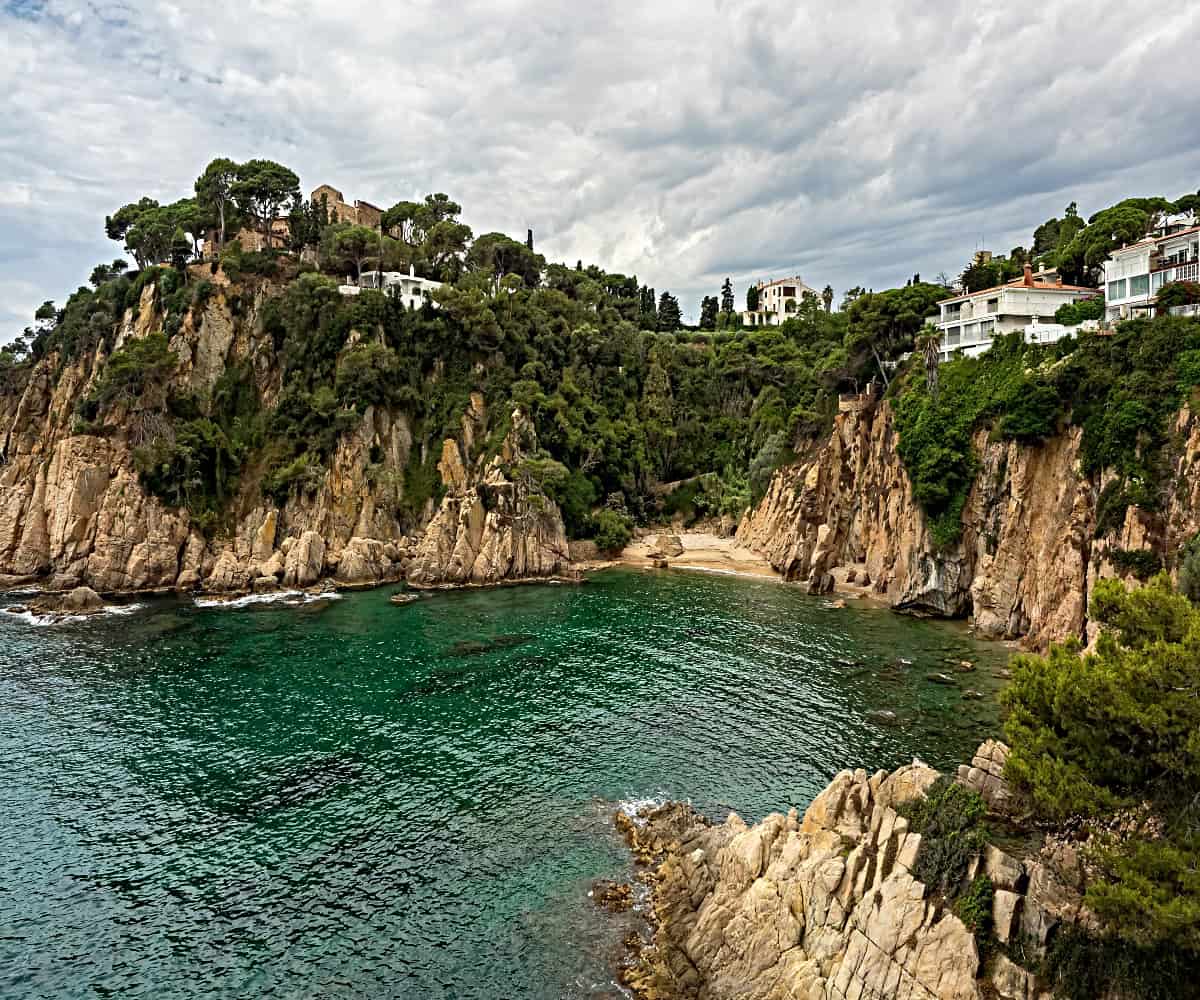
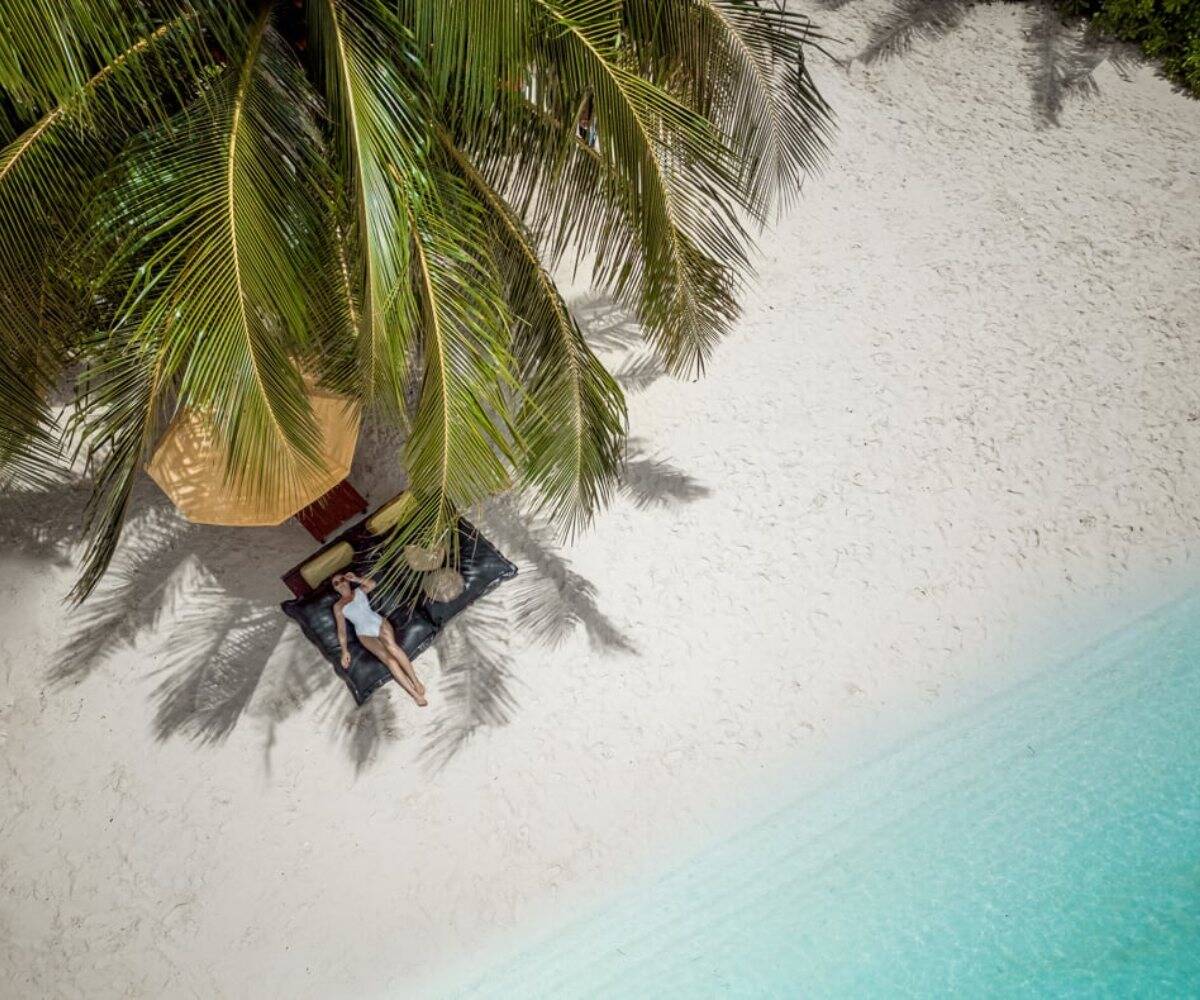


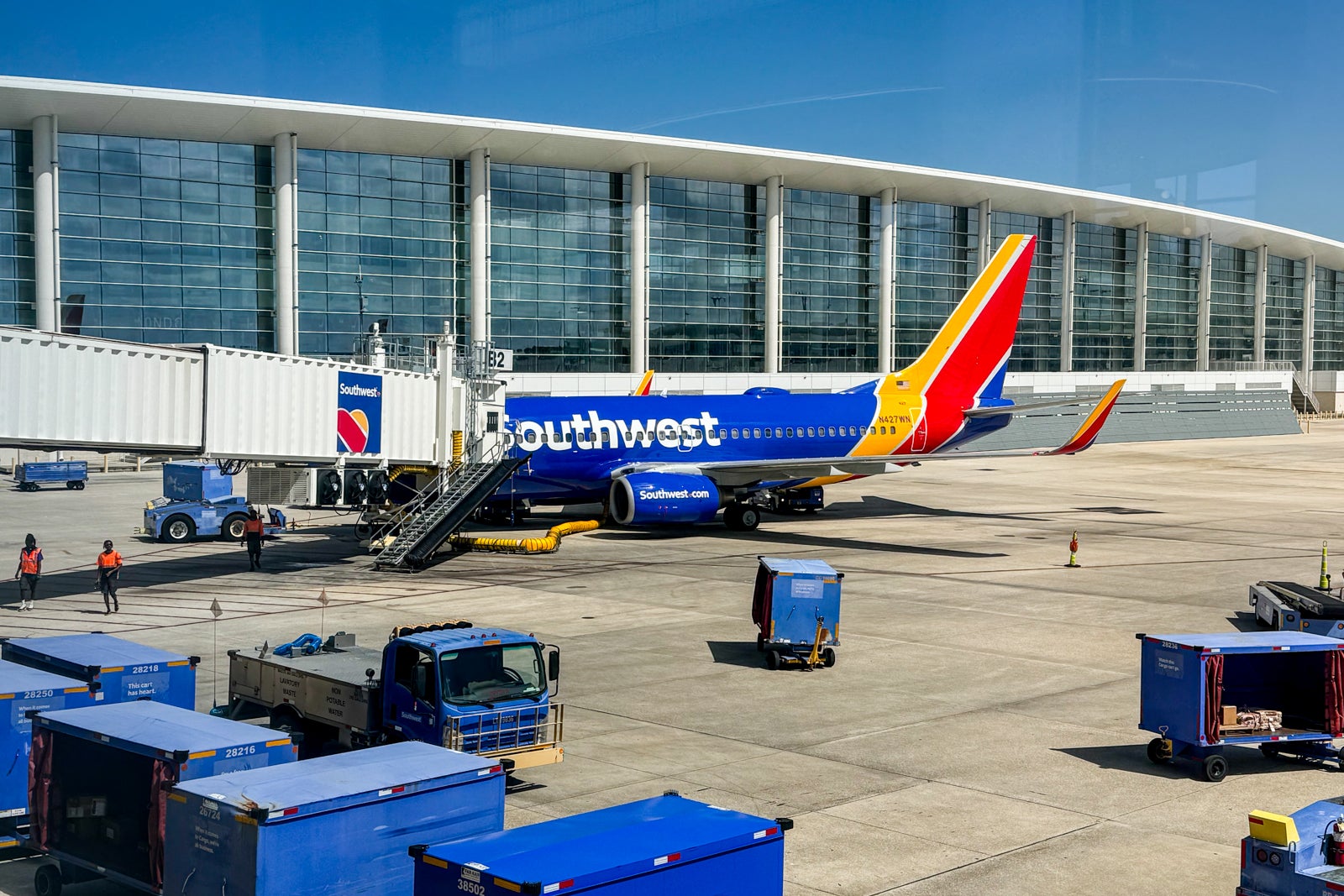
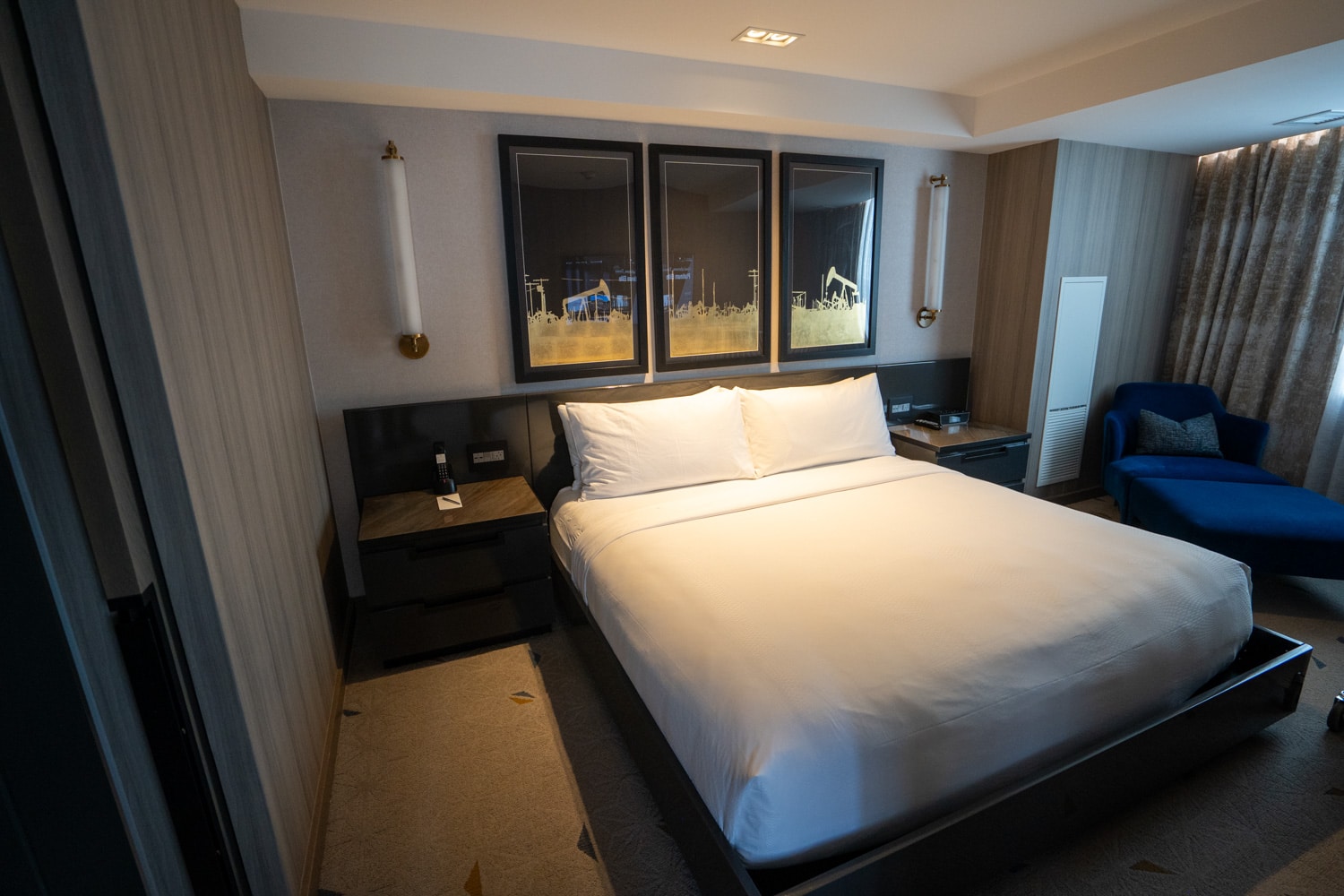
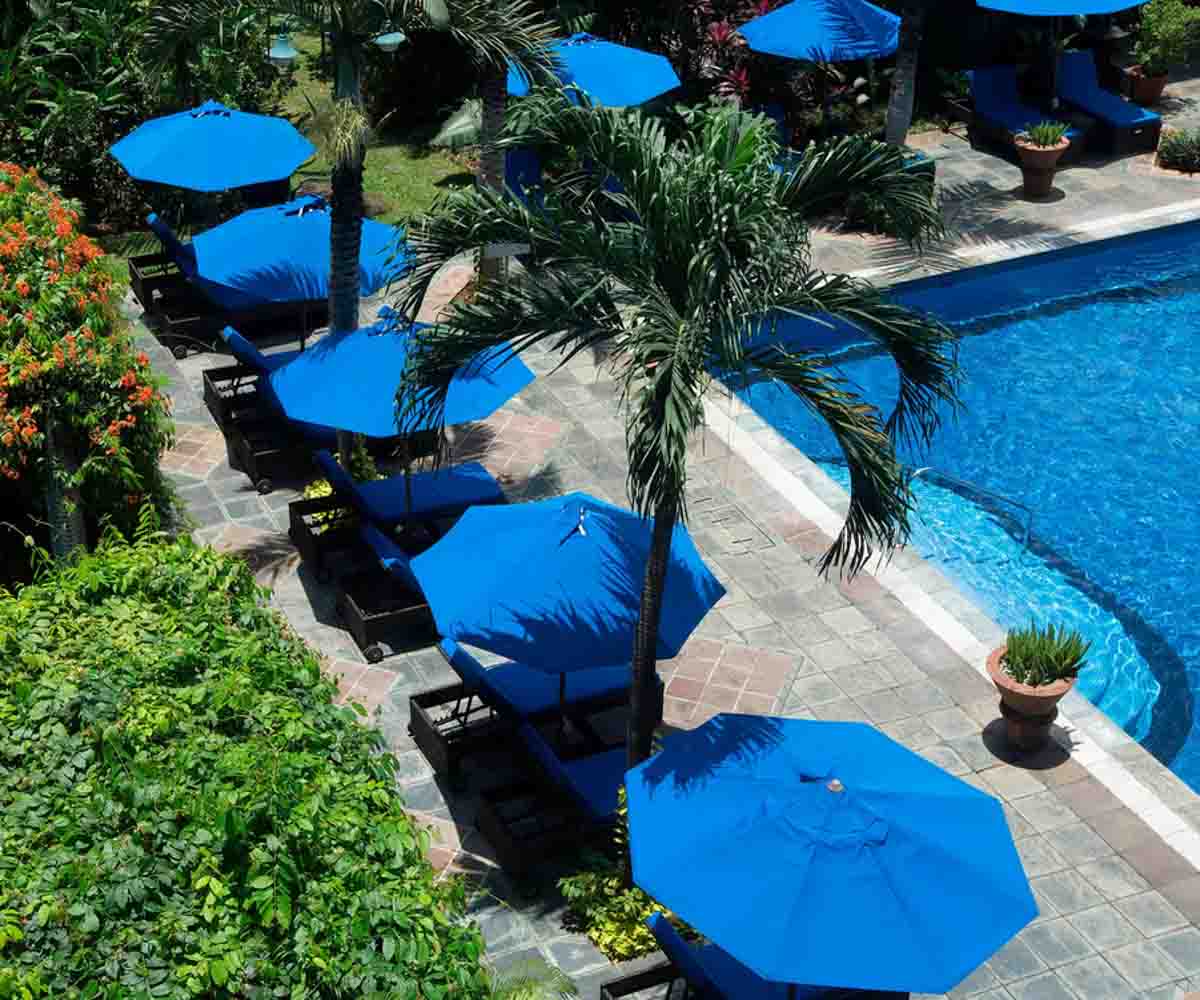
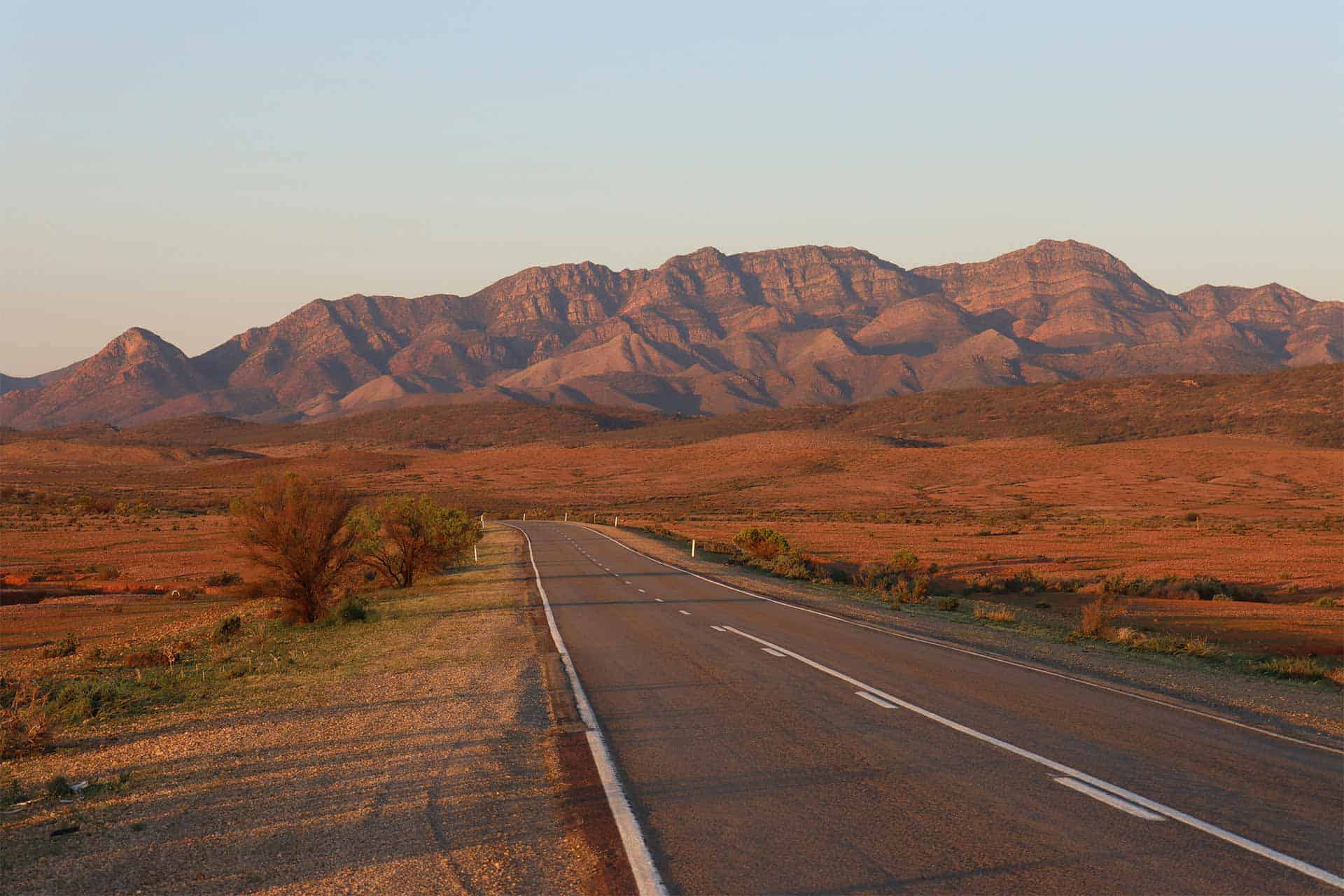

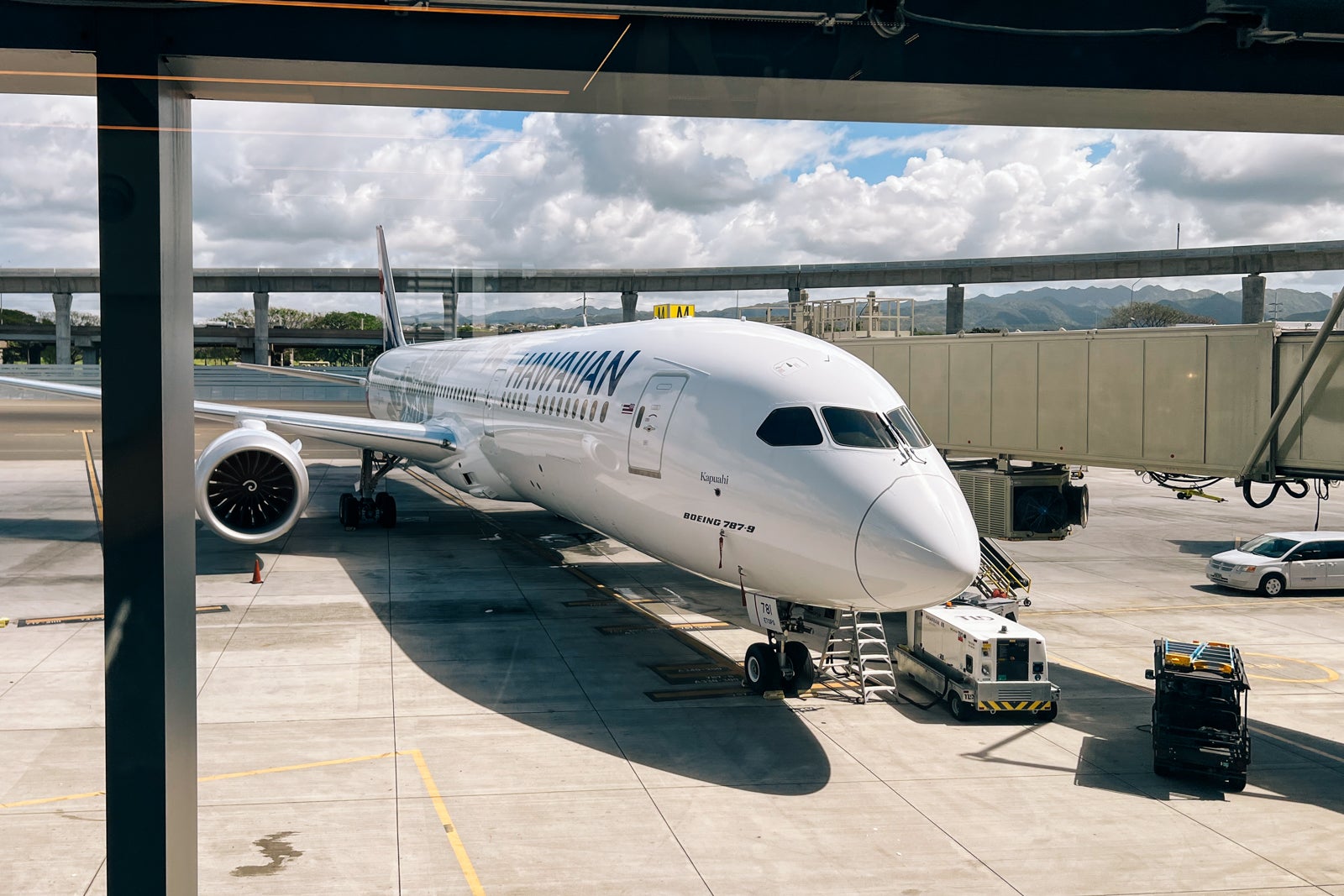
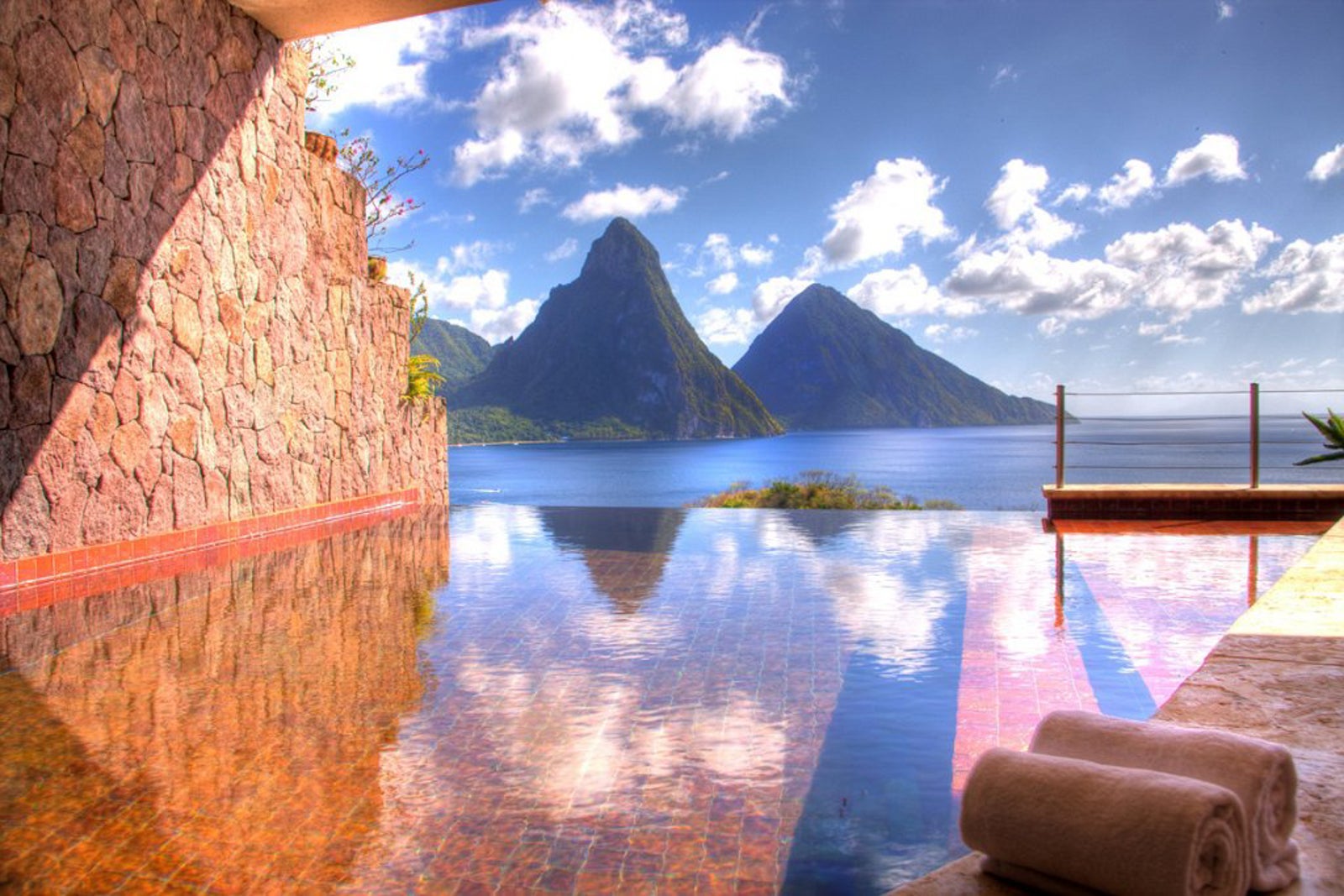
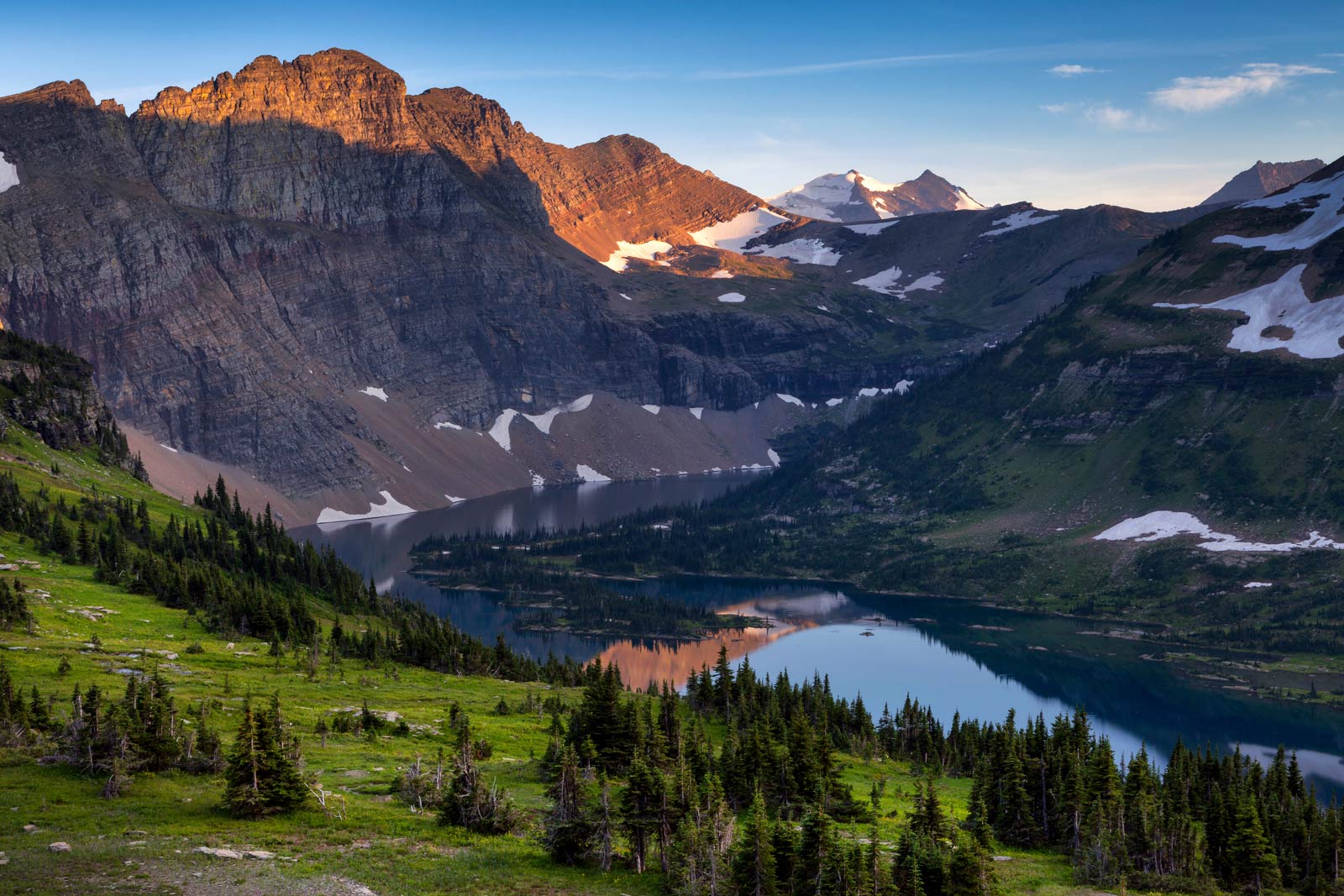




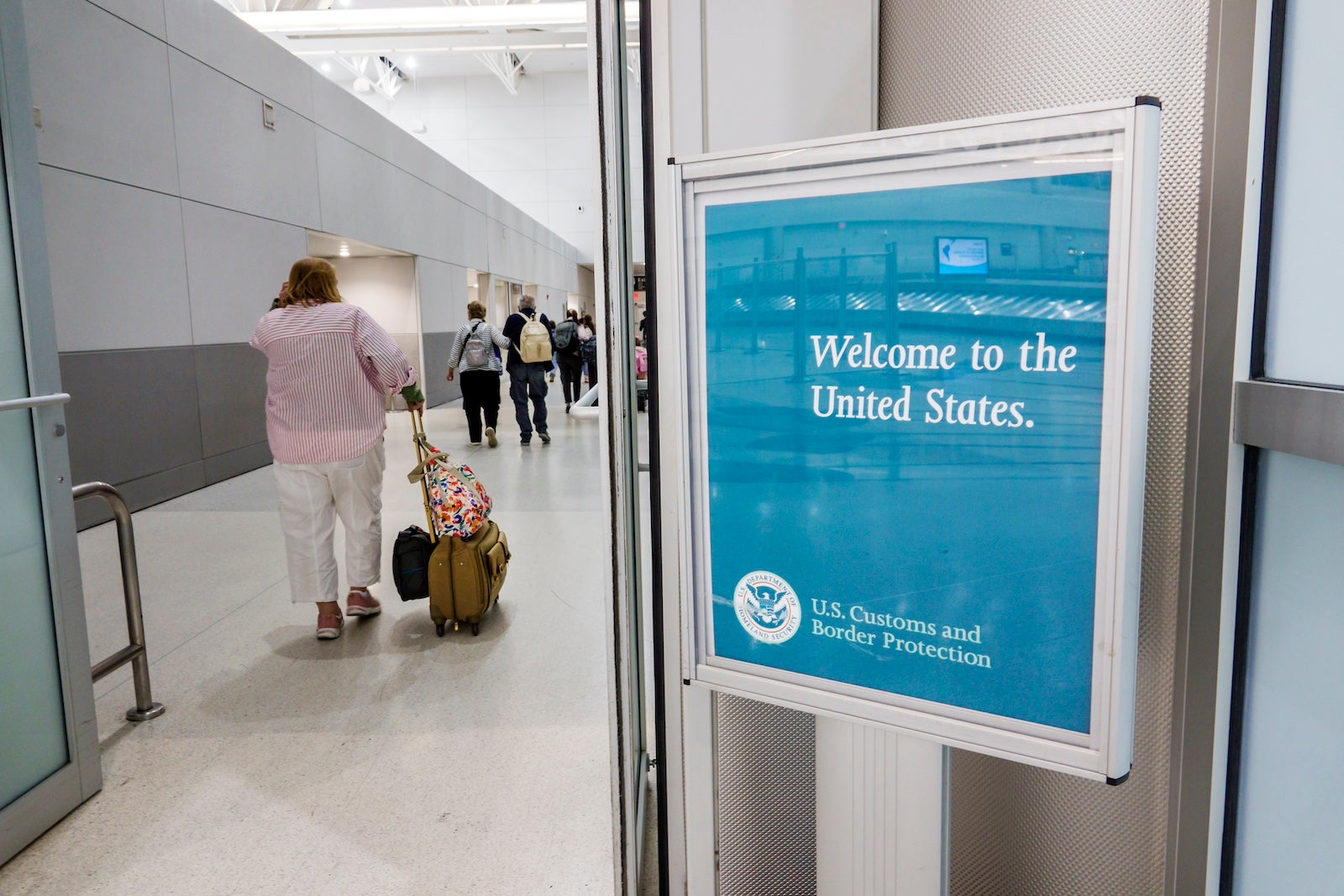

 English (US) ·
English (US) ·